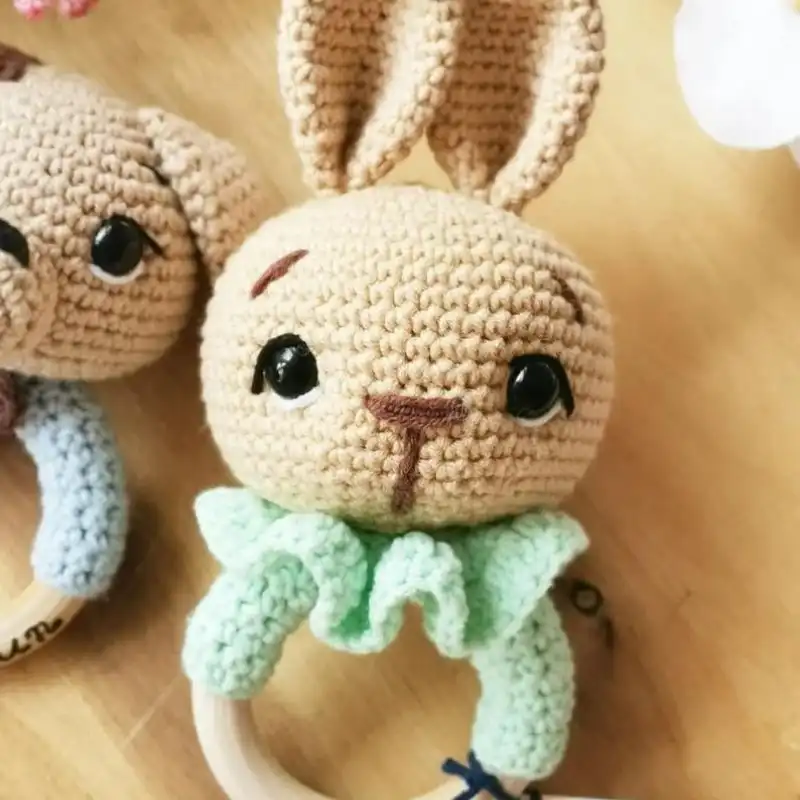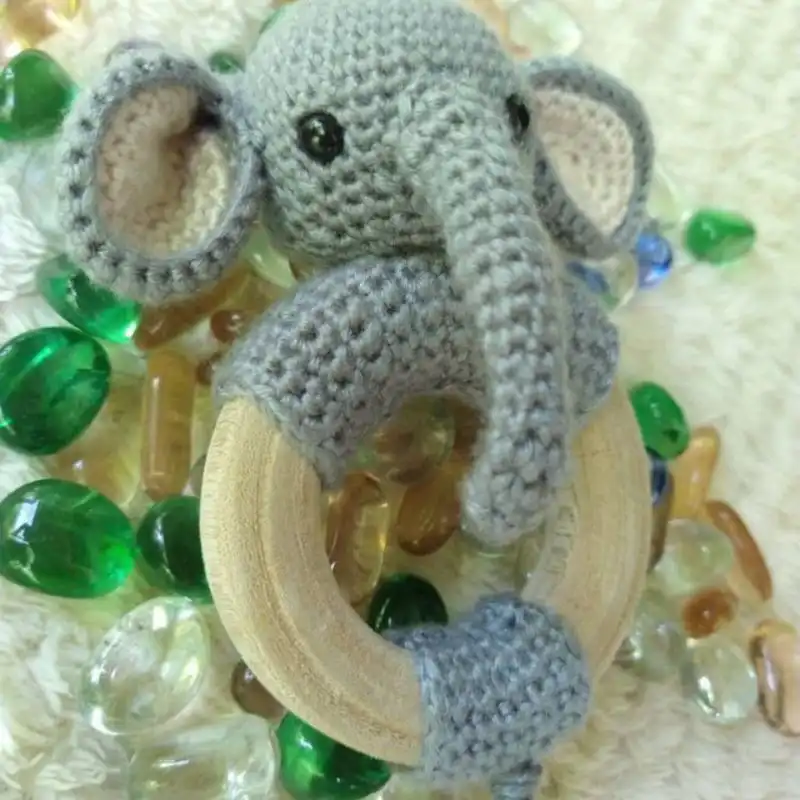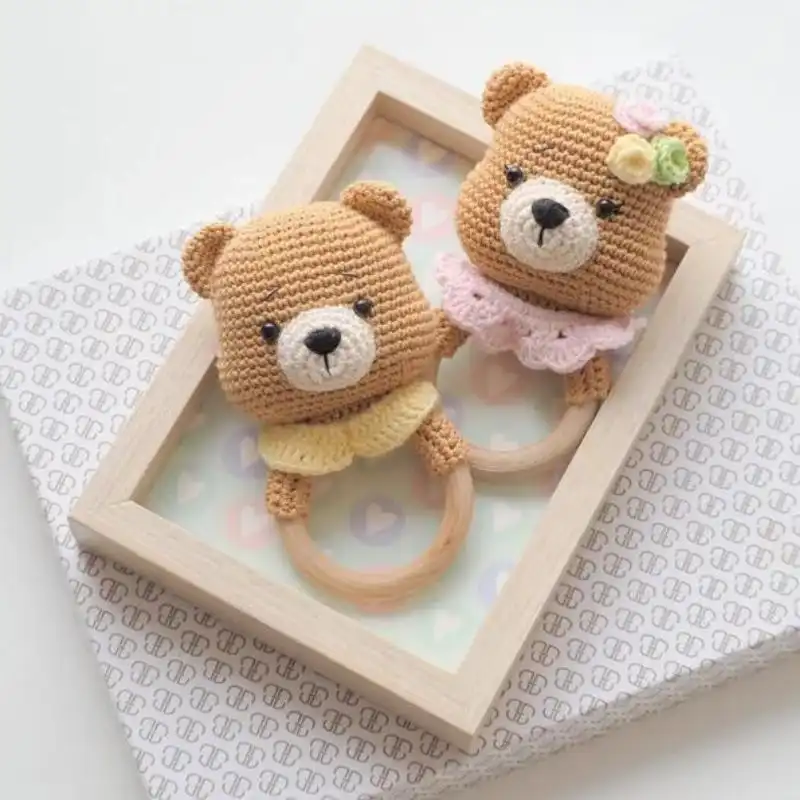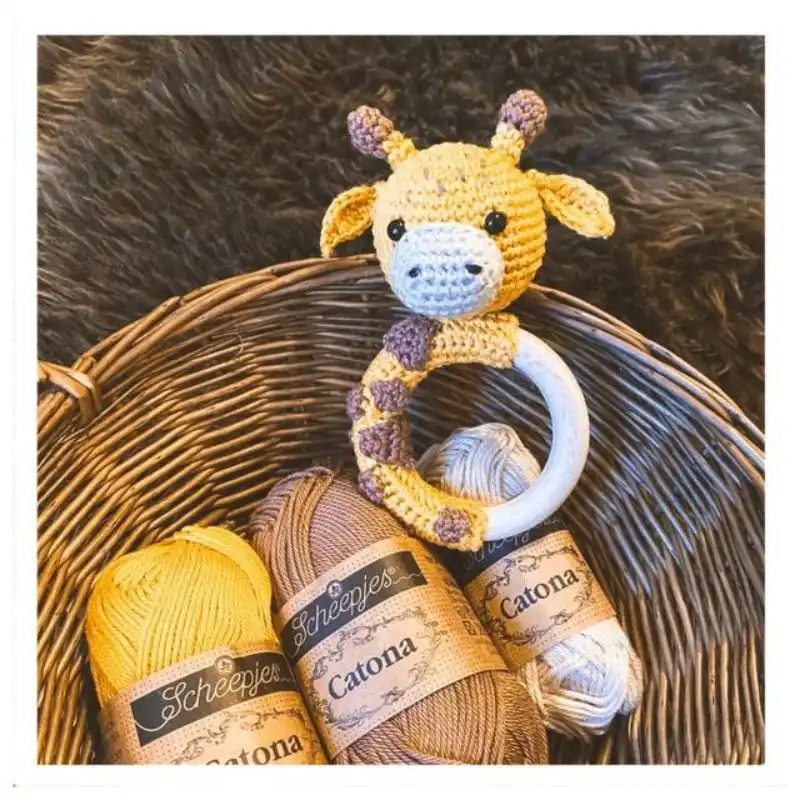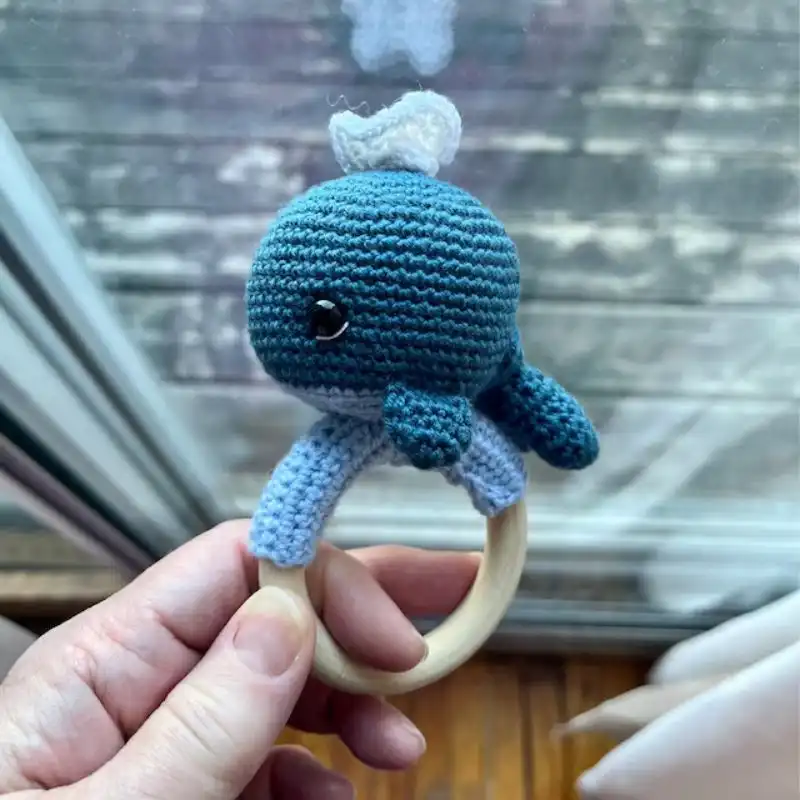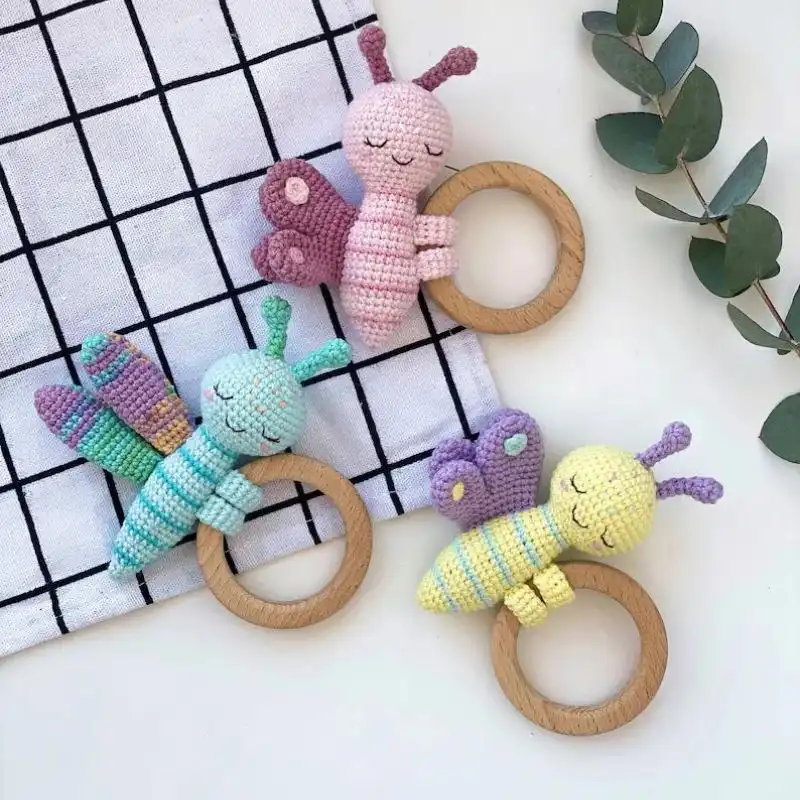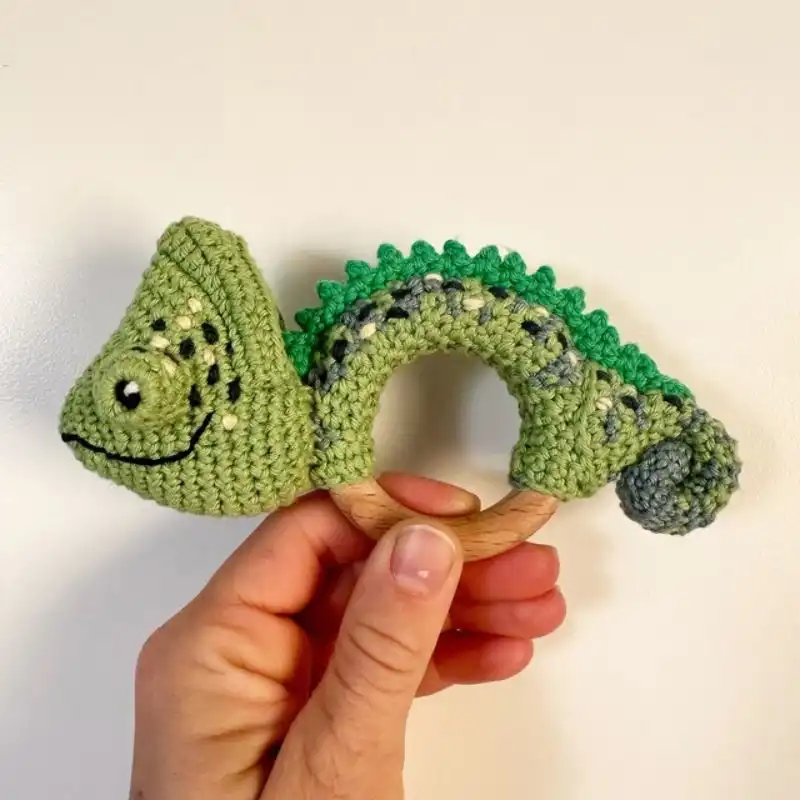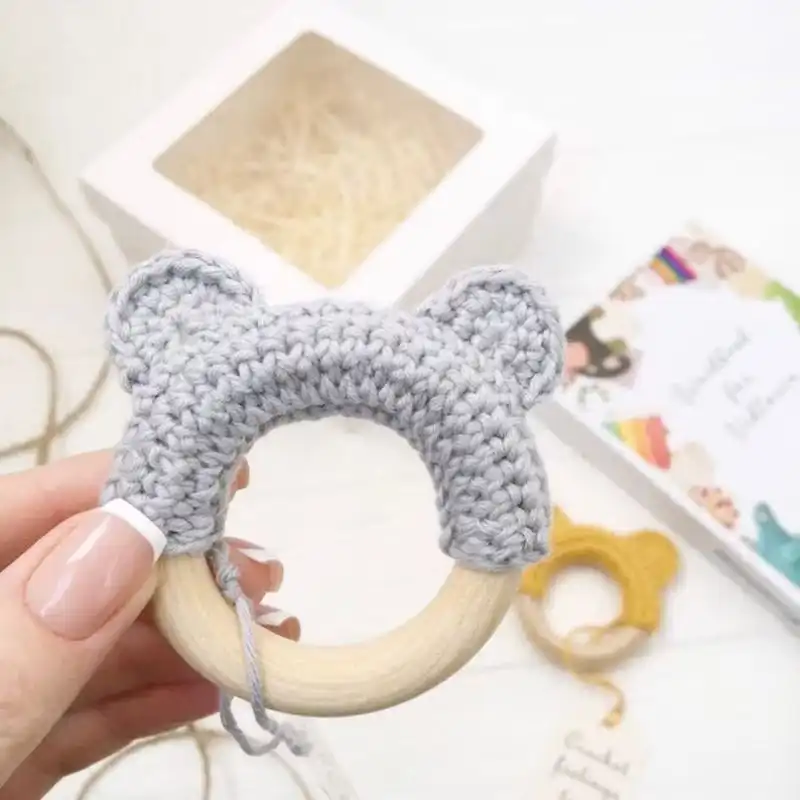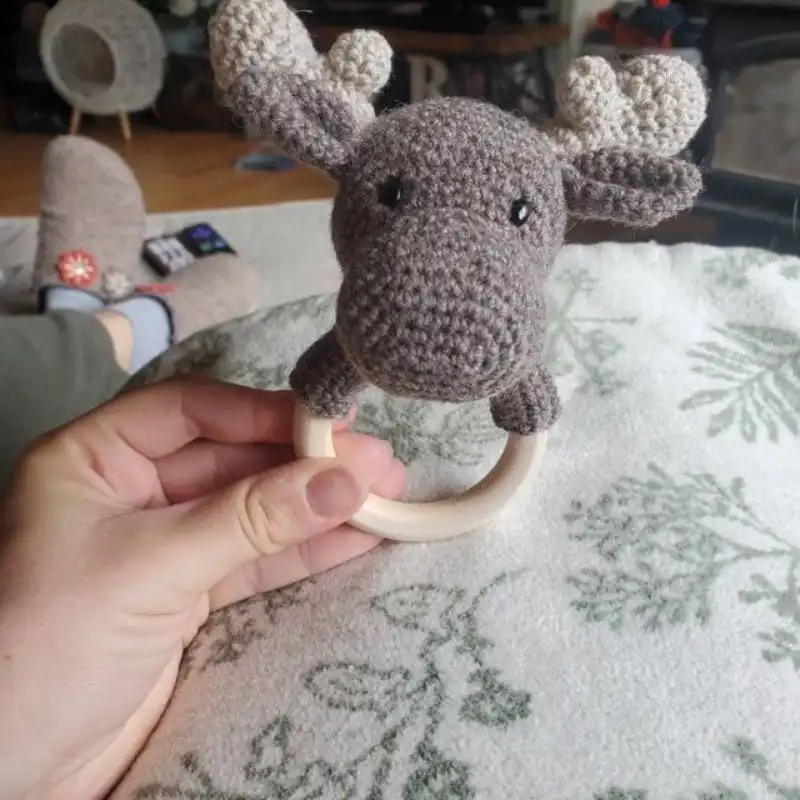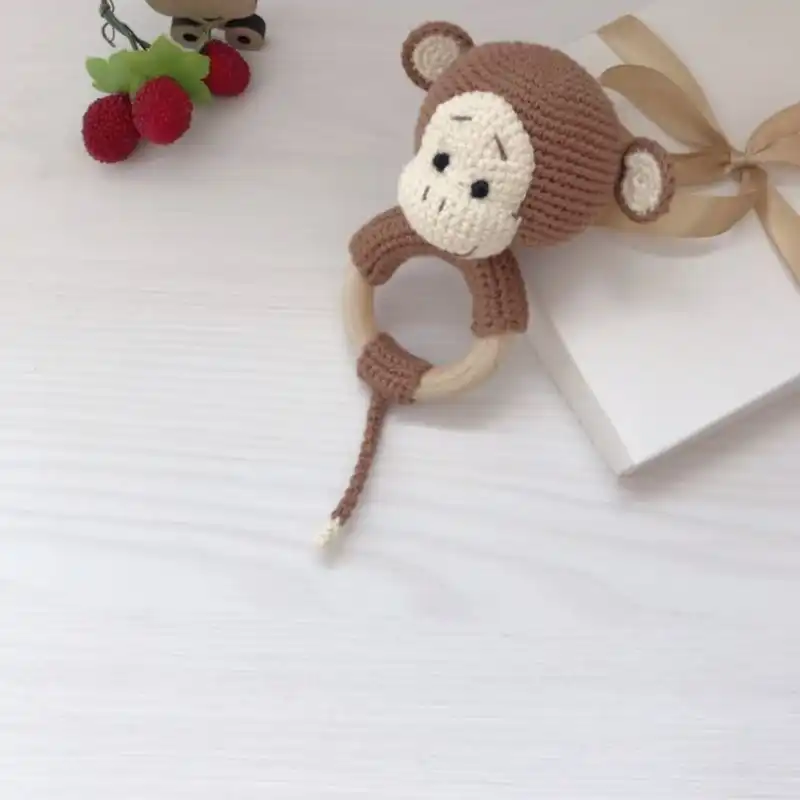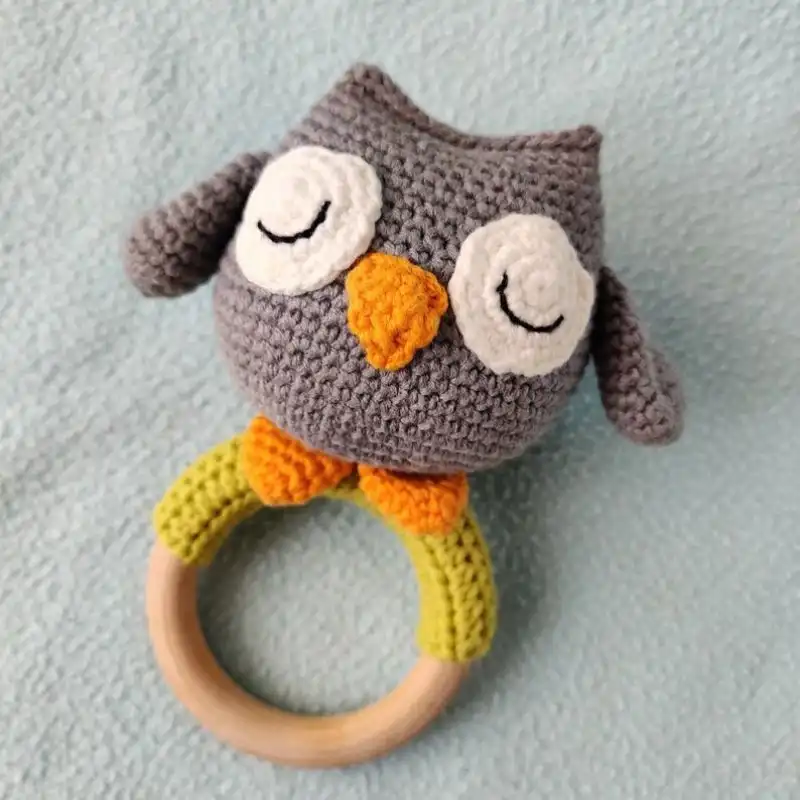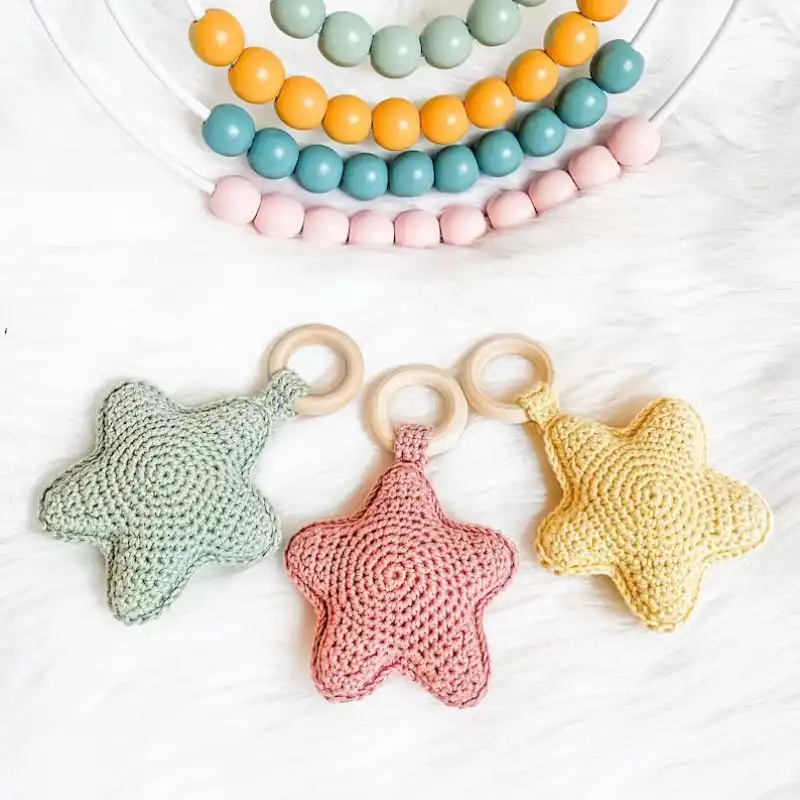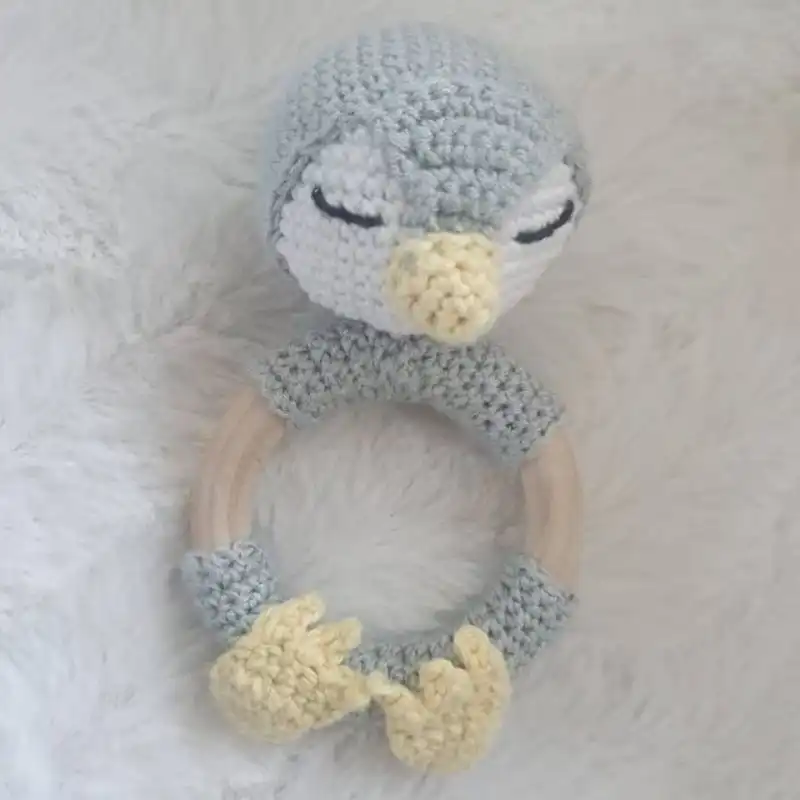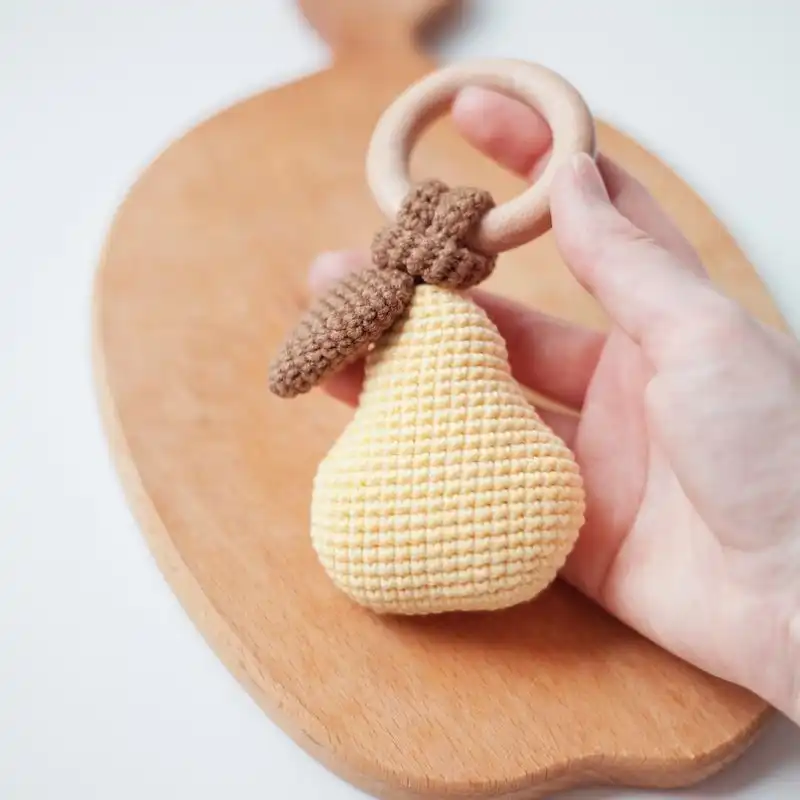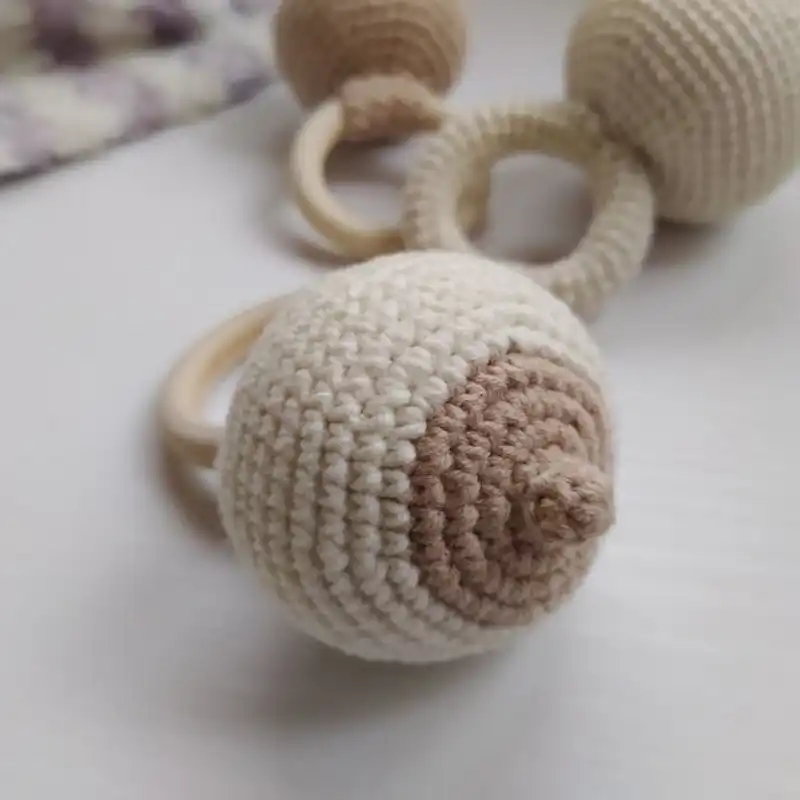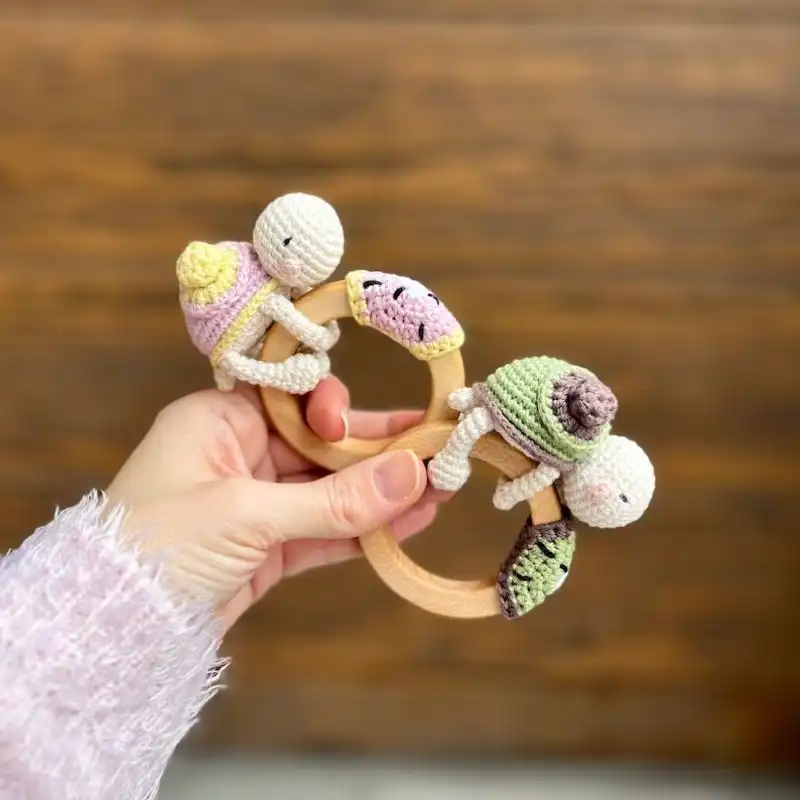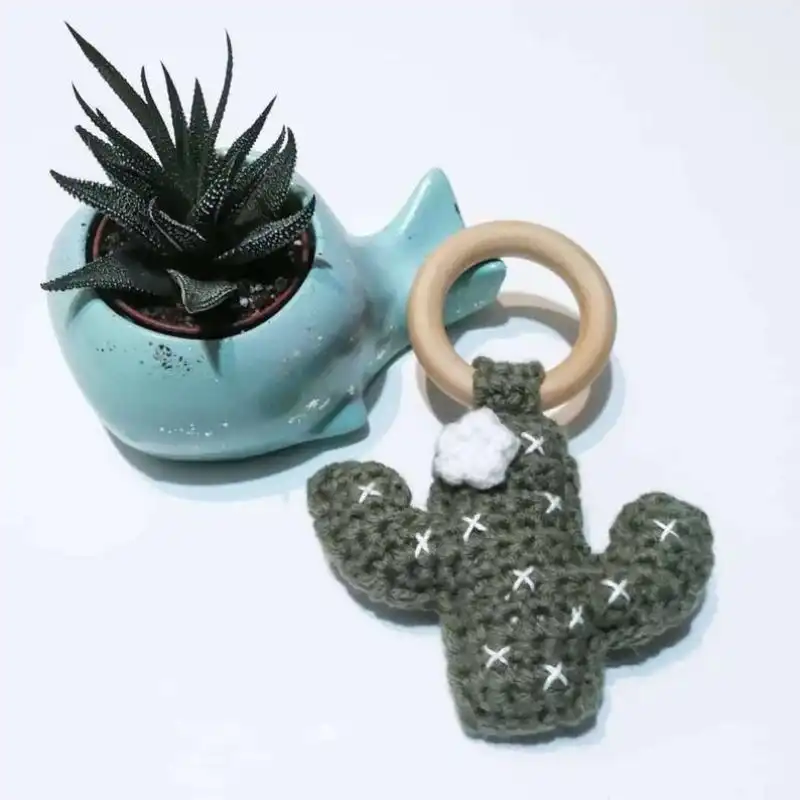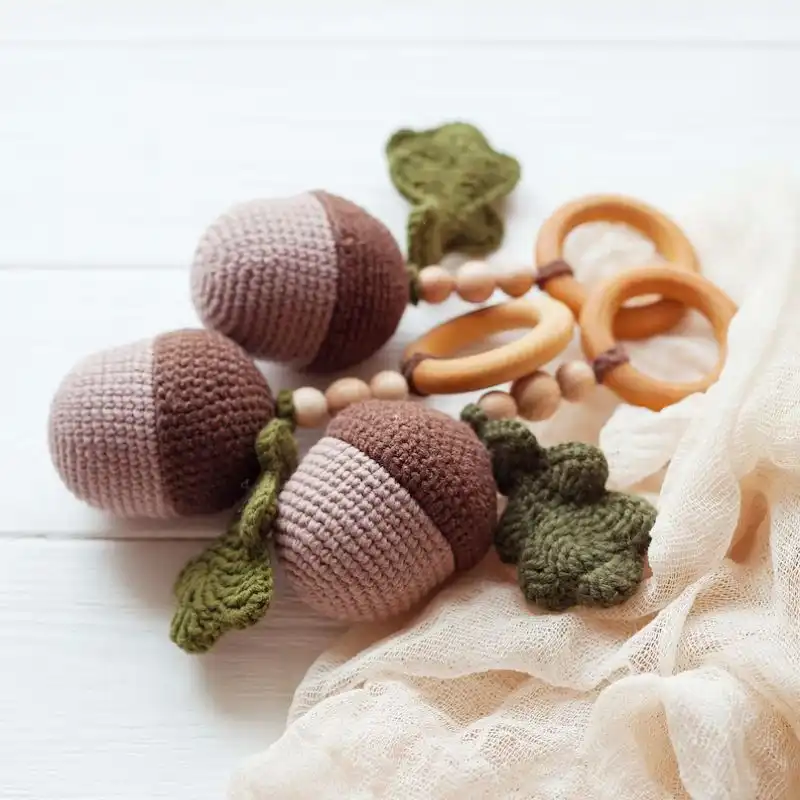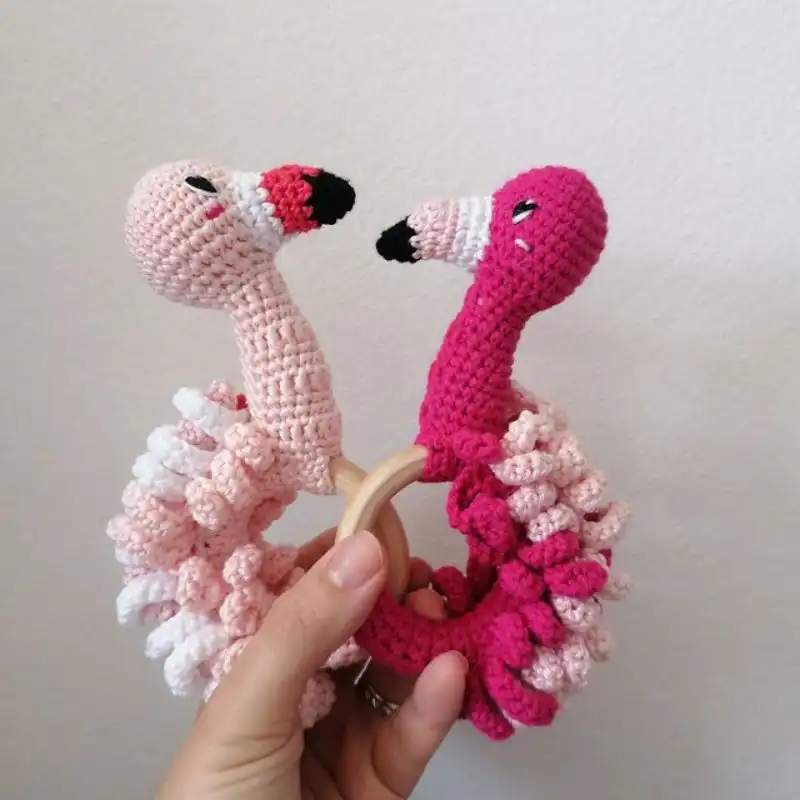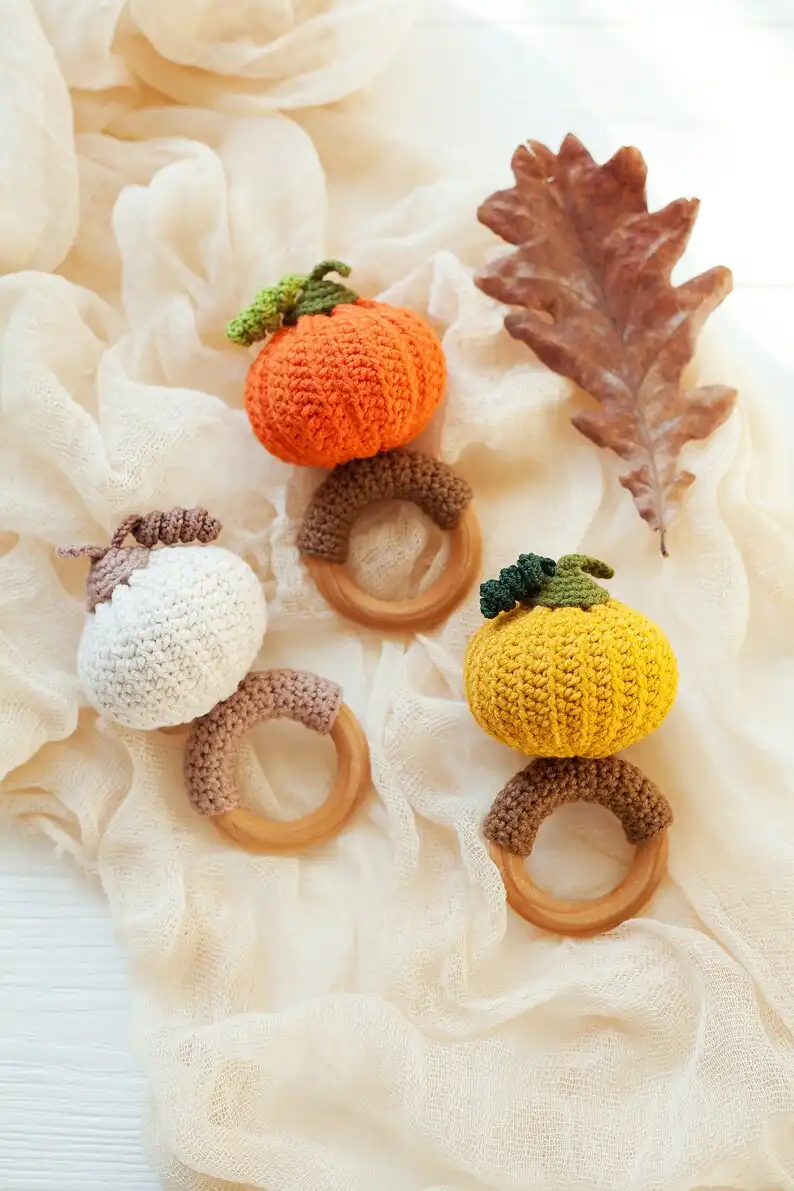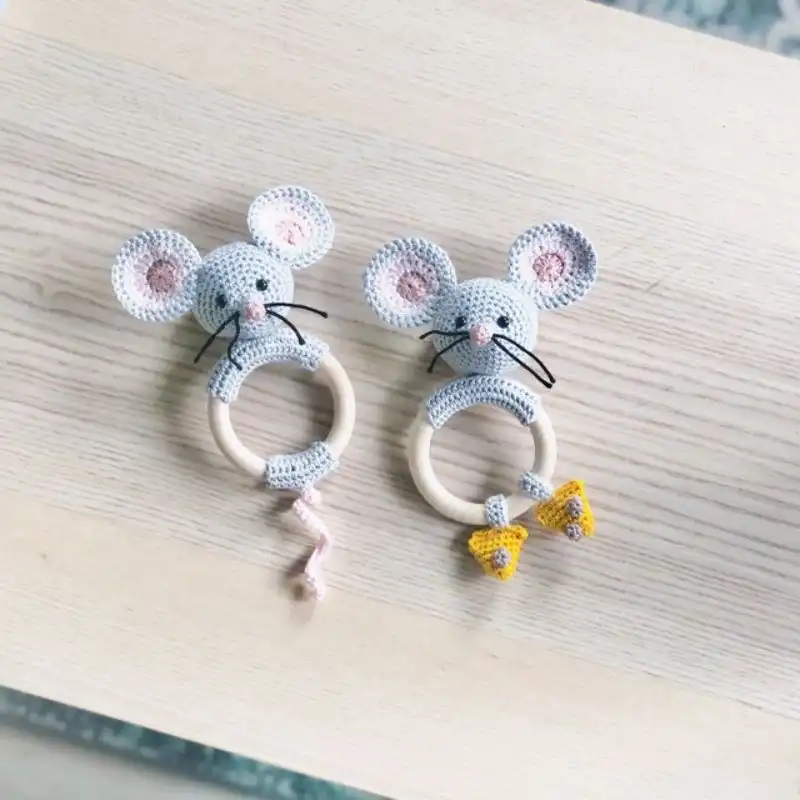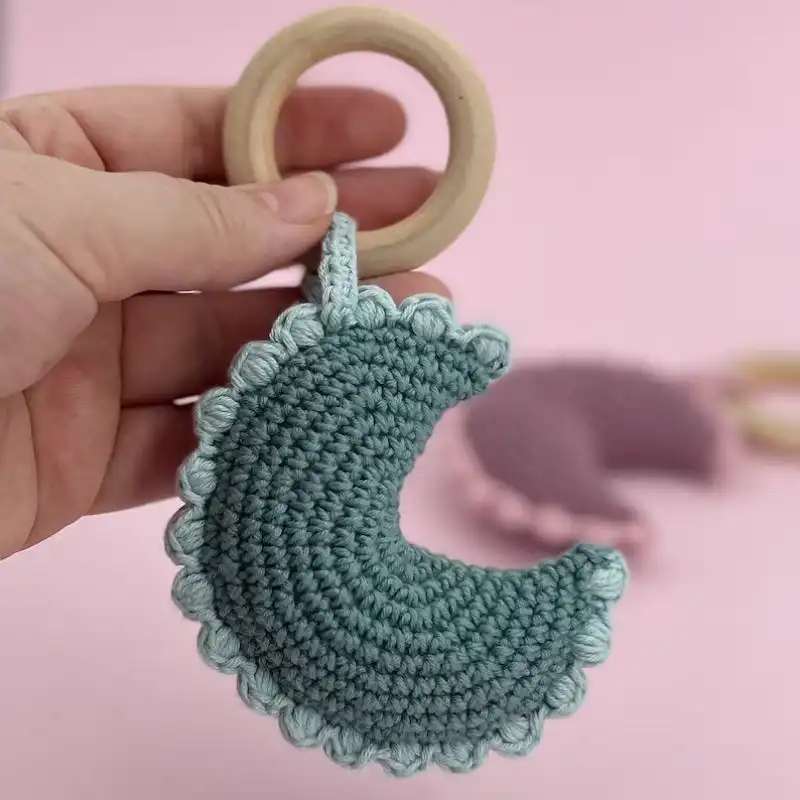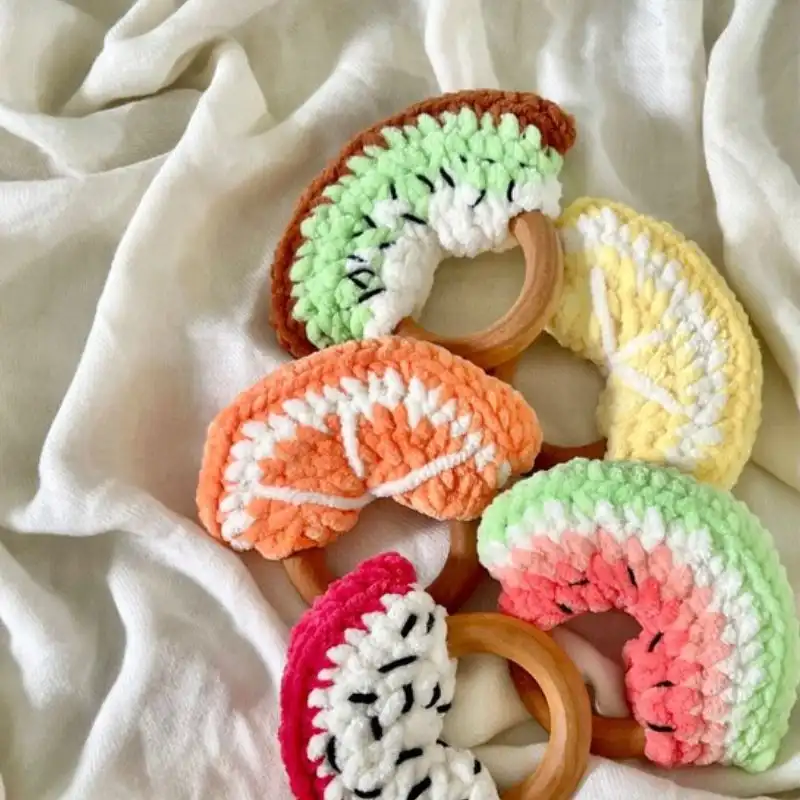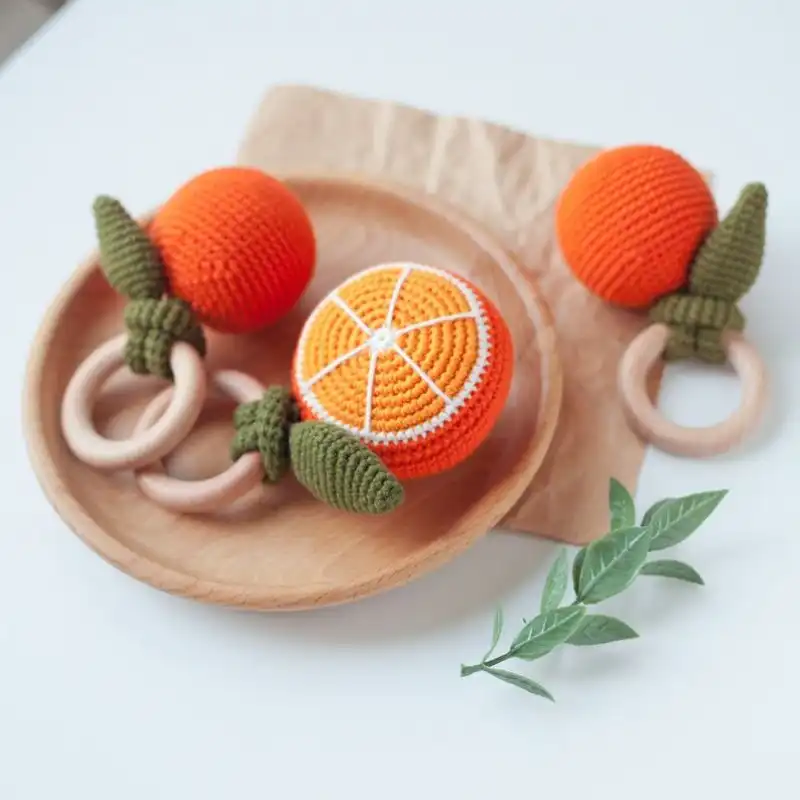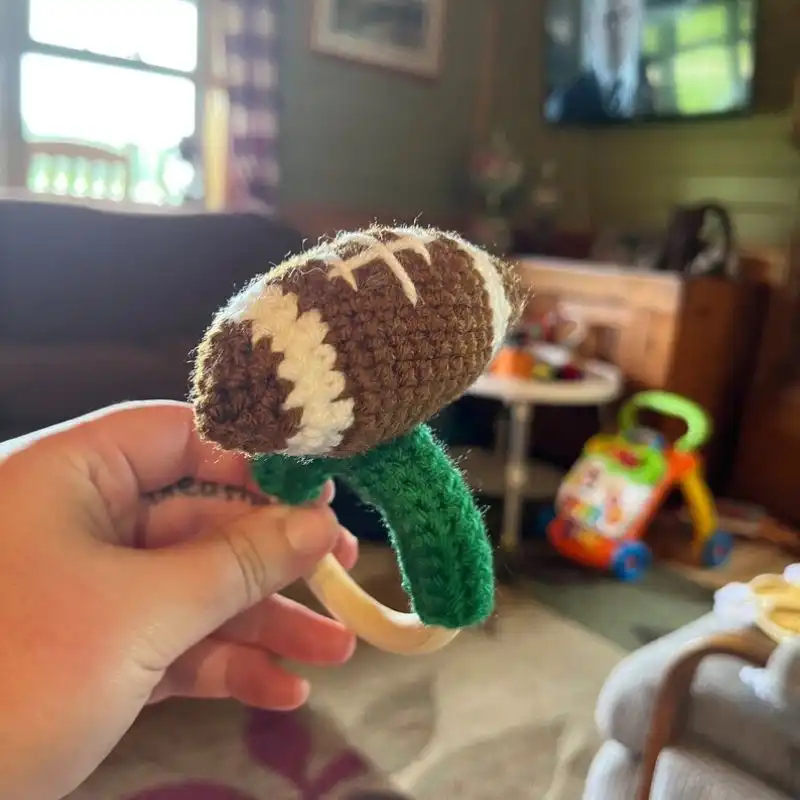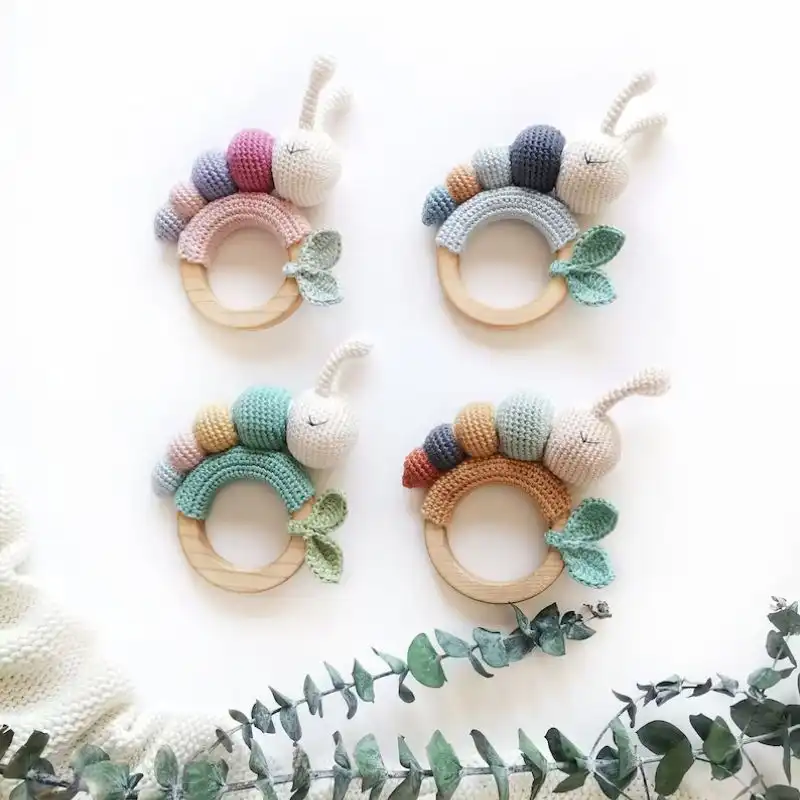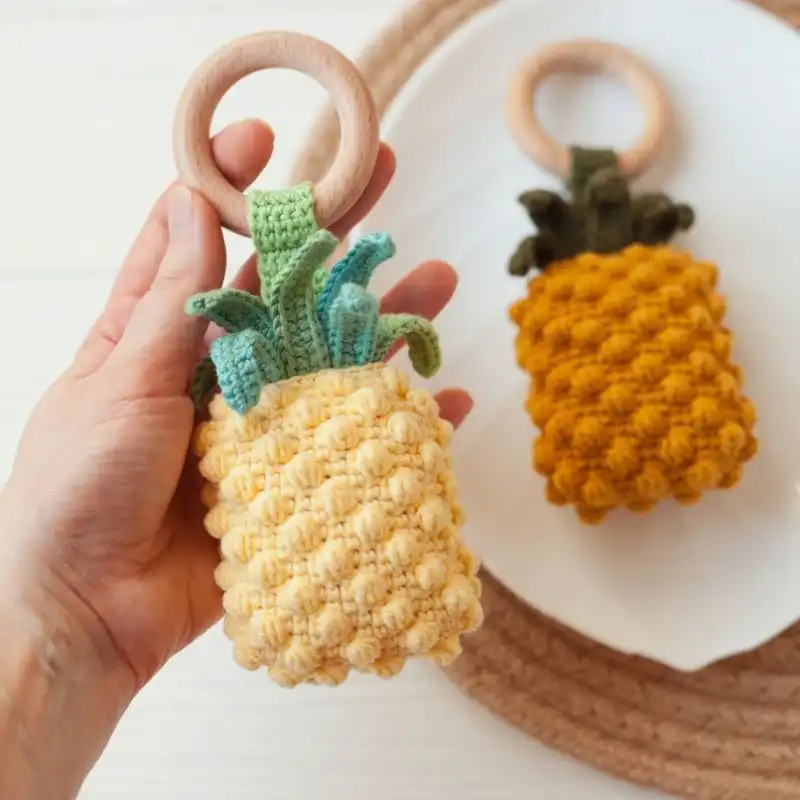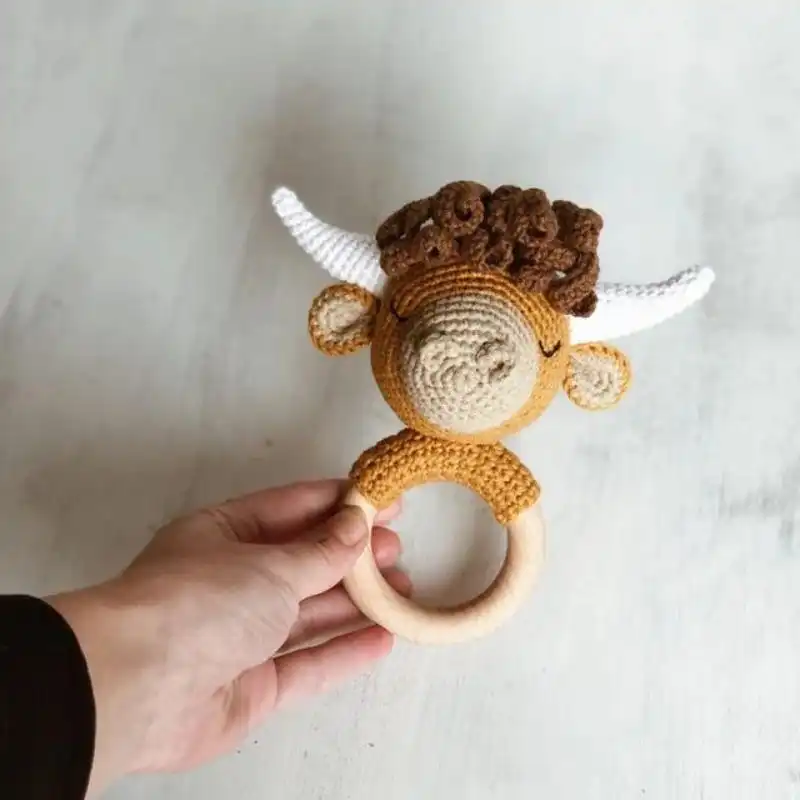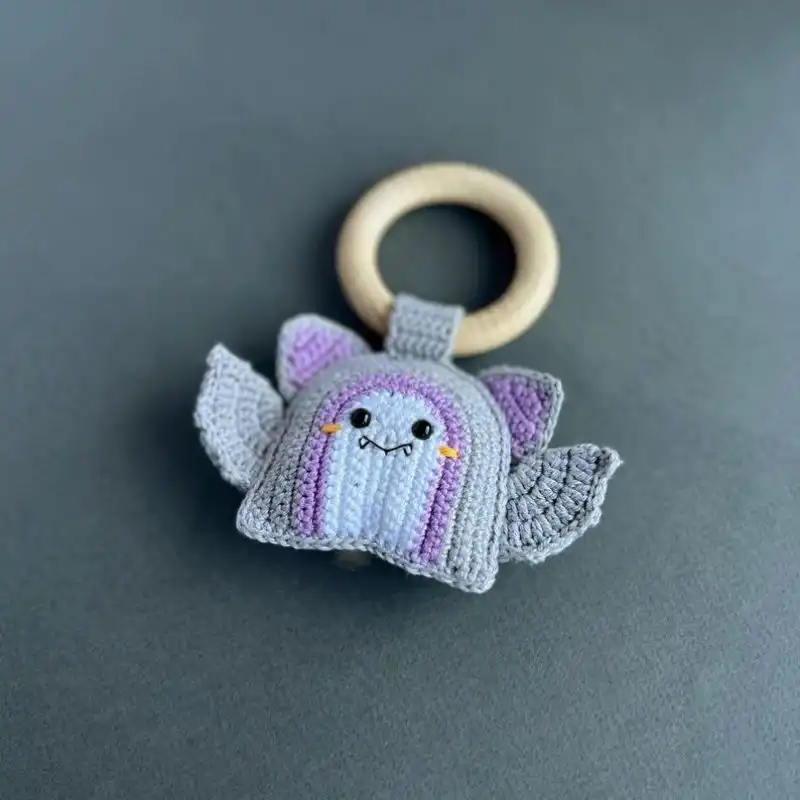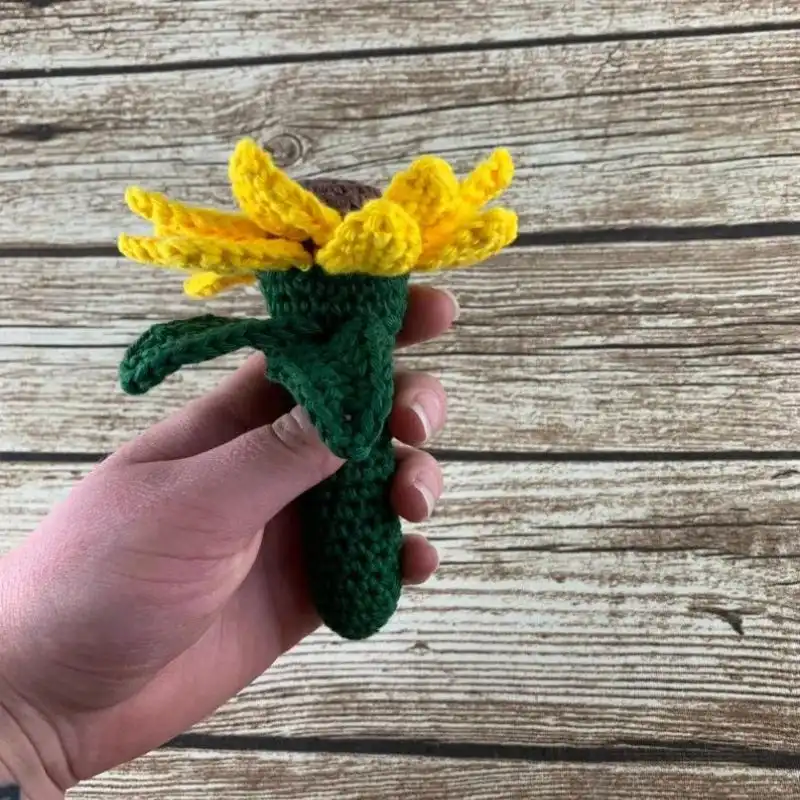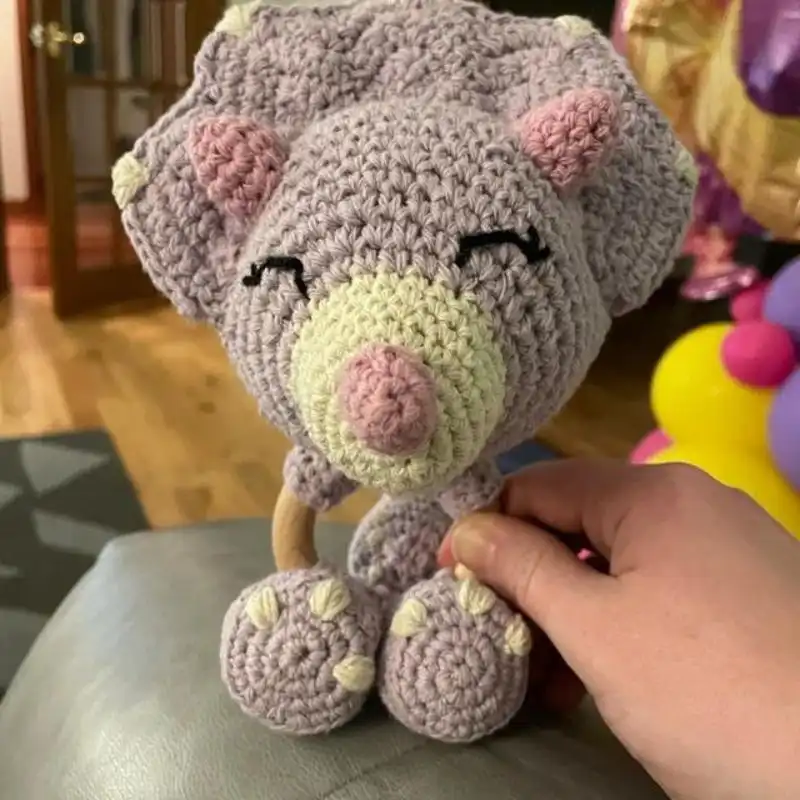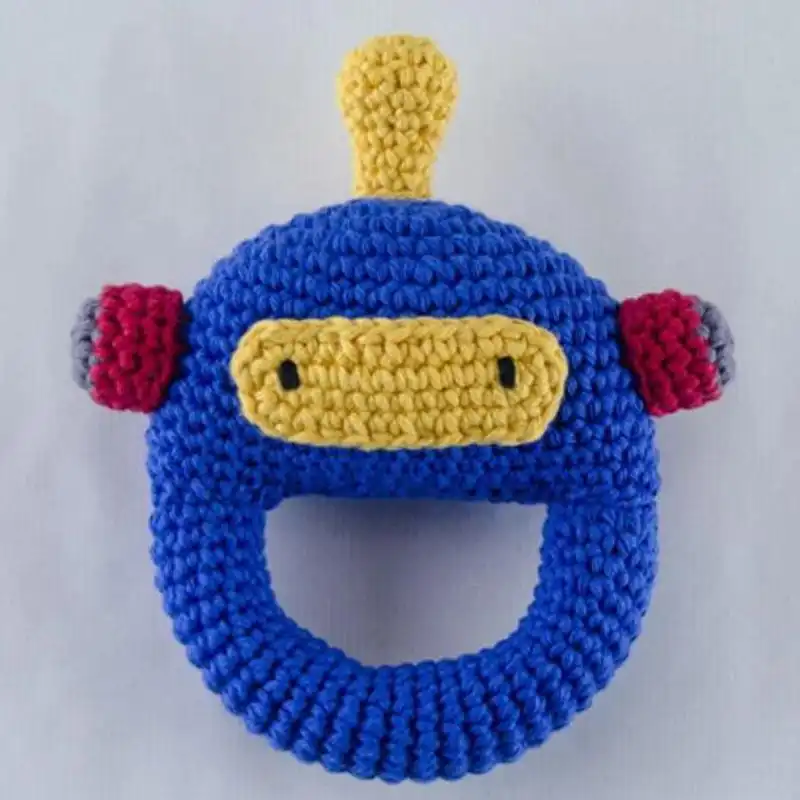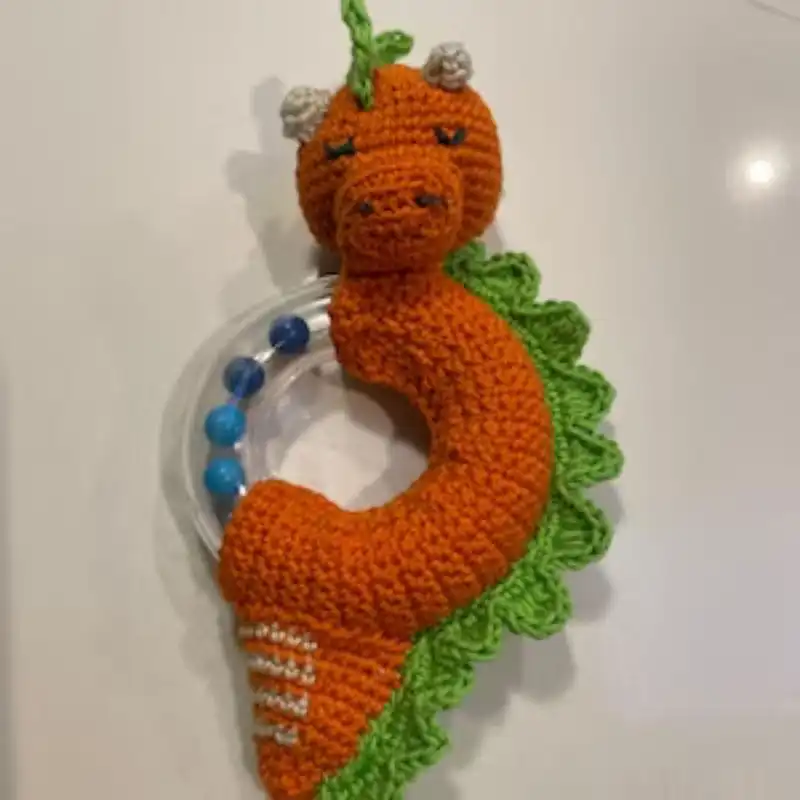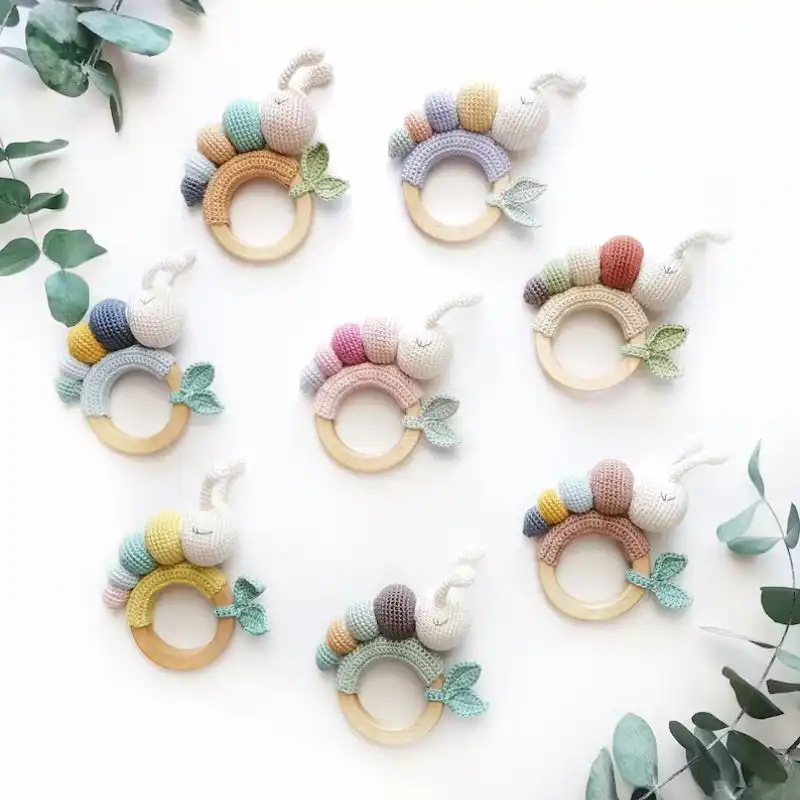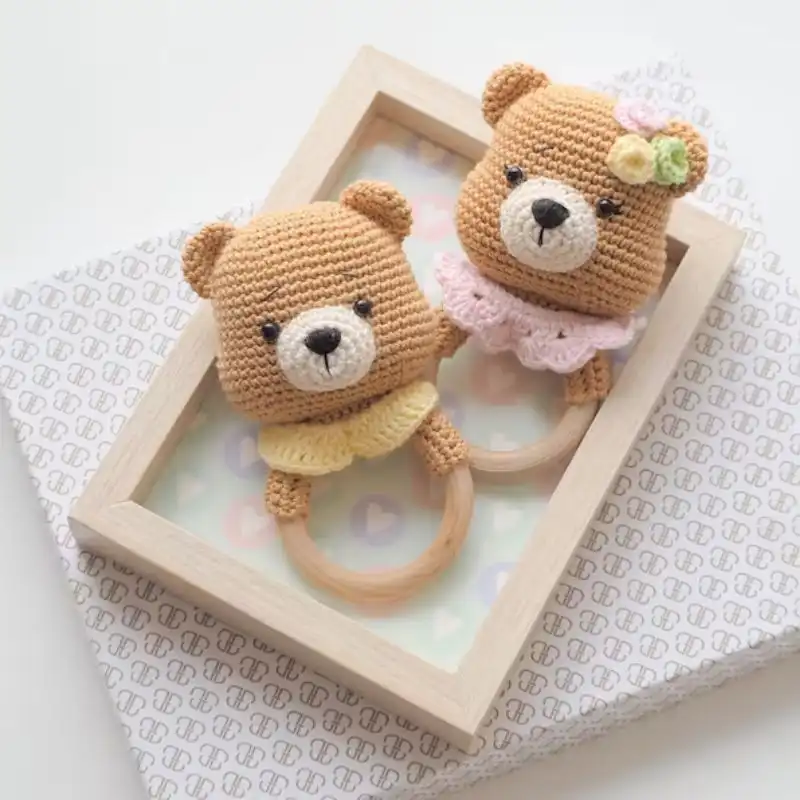The pitter-patter of tiny feet and the unique challenges they bring feel extraordinary! Every parent knows that teething tots and fidgety fingers need something safe and captivating. Those store-bought teethers? Often impersonal and sometimes even questionable in quality.

What if you could craft a treasure trove of delightful rattles and teethers with a crochet hook and some yarn? A world where each stitch tells a story of love, creativity, and care? Delightfully, I’ve gathered not one, not ten, but many crochet patterns for baby rattles and teethers.
As an expert crochet artist, I’ll guide you stitch by stitch to soothe and entertain those tiny gums and hands. With these, not only will you keep little ones happy, but you’ll also make memories that last a lifetime. Dive in, and let’s add a sprinkle of magic to those baby essentials!
Is It Worth To Crochet a Baby Rattles and Teethers?
Crocheting baby rattles, and teethers combines practicality with heartfelt sentimentality. These handcrafted items provide a safe, customizable solution for teething and tactile exploration and carry the warmth and love of every stitch made.
Choosing your materials ensures quality and safety for delicate baby gums. Moreover, these crocheted treasures become cherished keepsakes, often passed down through generations.
Beyond the tangible benefits, crocheting offers a meditative escape for the crafter. Crocheting baby rattles and teethers are an investment in quality, love, and memories.
If Crochet Baby Rattles and Teethers Are Safe For Babies?
From my years of experience and dedication to the craft, I can confidently say that crocheted baby rattles and teethers can be safe for babies, but it’s all about the details. First and foremost, selecting the right, non-toxic yarn and materials is crucial.
I always ensure tight stitches to prevent any little fingers from getting caught. Furthermore, it’s essential to avoid any small detachable parts that could be a choking hazard.
Regular inspections for wear and tear are a must. When crafted with care and mindfulness, these handmade treasures can be safe and heartwarming additions to a baby’s collection.
Various Stitches To Crochet Baby Teethers And Rattles
Here are some basic stitches to crochet baby teethers and rattles, with a brief explanation for each:
Chain Stitch (ch): The foundation of most crochet projects. Yarn is pulled through an active loop on the hook to create a series of interconnected loops.
Single Crochet (sc): A compact and tight stitch, providing a dense fabric ideal for teethers. Insert the hook, yarn over, pull through, yarn over again, and pull through both loops on the hook.
Half Double Crochet (hdc): A stitch taller than a single crochet. Insert the hook, yarn over, pull through, yarn over, and pull through all three loops on the hook.
Double Crochet (DC): Creates a softer, more flexible fabric. Yarn over, insert the hook, yarn over, pull through, yarn over, pull through two loops, yarn over again, and pull through the remaining two loops.
Slip Stitch (sl st): Used to join stitches or move across rows without adding height. Insert the hook into the stitch, yarn over, and pull the yarn through both the stitch and the loop on the hook.
Magic Ring (or Magic Circle): A technique to start projects like amigurumi (stuffed toys), including rattles. It allows you to work several stitches into a loop and close it tightly.
Increase (inc): Involves making two stitches in one stitch from the previous row. It helps to expand the work in creating rounded shapes like rattle heads.
Decrease (dec): Combining two stitches from the previous row into one. It contracts the work, helping shape 3D forms for amigurumi-style rattles.
Bobble Stitch: This creates a pronounced ‘bump’ in the fabric, which can be interesting for babies to touch. It’s made by partially completing several double crochets in the same stitch and then joining them together.
What Is The Ideal Size Of Crochet Teethers And Rattles?
When crocheting teethers and rattles for babies, size is crucial for functionality and safety.
Functionality
- Hand Grip: Babies have tiny hands. Teethers and rattles need to be sized to allow babies to grip them comfortably. If it’s too big, they’ll have difficulty holding onto it; if it’s too small, it might not be as engaging or could easily be lost.
Safety Concerns
- Choking Hazard: The primary safety concern is ensuring the teether or rattle is not small enough to be a choking hazard. According to safety standards in many countries, any toy or part of a toy that fits inside a cylinder approximately 1.25 inches (about 3.2 cm) in diameter and 2.25 inches (about 5.7 cm) in height poses a choking risk for children under three years old. It’s a good practice to size baby items well above this standard.
- Comfort for Mouth: Teethers will especially end up in babies’ mouths. The size should be such that it’s comfortable for a baby to gum on without posing any risk of gagging or injury.
General Sizing Recommendations
Teethers: These are often ring-shaped. A diameter of 3 to 4 inches (7.5 to 10 cm) usually works well. If you add appendages, like little crocheted animals or shapes, ensure they’re securely attached and don’t pose a choking risk.
Rattles: Rattles can be a bit more varied in shape. A standard size for a cylindrical or spherical rattle might be around 4 to 6 inches (10 to 15 cm) in length or diameter. However, this can vary depending on the design. Some rattles designed like animals or other shapes might differ in dimensions, but they should still be easy for a baby to grasp and shake without difficulty.
Essential Tools And Materials
Creating baby rattles and teethers requires specific tools and supplies to ensure the item’s functionality and safety. Here’s a list of essentials:
- Cotton Yarn: It’s absorbent, soft, durable, and easy to clean. Choose yarns labeled as baby-friendly or hypoallergenic to ensure they’re gentle on a baby’s delicate skin and free from harmful chemicals.
- Crochet Hooks: Choose a size that corresponds with your chosen yarn weight. For most baby items, smaller hooks (like sizes E-G or 3.5-4.5mm) are commonly used to create tight stitches, ensuring no gaps where tiny fingers might get stuck.
- Rattle Inserts or Jingle Balls: These specially designed plastic capsules make noise when shaken. They’re safely encased inside the crochet work to add the rattle effect.
- Wooden Rings: Untreated, smooth wooden rings are popular for crochet teethers. They’re natural, and when appropriately sanded, they’re safe for babies to chew on.
- Silicone Rings: Food-grade silicone rings are another excellent choice. They’re soft on baby’s gums and easy to clean.
- Stitch Markers: Useful for marking the beginning or specific points of a round, especially when working in continuous spirals, which is typical for amigurumi-style rattles.
- Darning or Tapestry Needle: For weaving in yarn ends securely. Ensuring no loose ends is crucial for baby items.
- Safety Eyes (optional): If your rattle design has animal or character features. Ensure these are labeled “safety eyes,” meaning they lock in place and are difficult to remove. Alternatively, you can embroider eyes with yarn to eliminate any choking hazard.
- Stuffing: Polyester Fiberfill: It’s lightweight, washable, and hypoallergenic. Ensure it’s packed tightly inside the rattle to retain its shape, but not too tight that it over-stretches the stitches.
- Scissors: A sharp pair for cutting yarn cleanly.
- Ruler or Measuring Tape: To check the dimensions of the teether or rattle, ensuring it’s of appropriate and safe size.
- Safety Note: Always ensure that all components are securely fastened, and regularly inspect handmade baby items for wear and tear. If any part becomes loose or damaged, it’s essential to repair or replace the item to ensure ongoing safety for the baby.
Glossary Of Crochet Stitches And Techniques
Here’s a glossary of common crochet stitches and techniques:
Basic Stitches
- ch (Chain Stitch): The foundation of most crochet projects; a series of simple loops.
- Sl st (Slip Stitch): A stitch used to move across or join stitches without adding height.
- Sc (Single Crochet): The most basic crochet stitch that produces a tight, dense fabric.
- hdc (Half Double Crochet): A stitch midway in height between single and double crochet.
- DC (Double Crochet): A taller stitch-producing looser fabric.
- tr (Treble or Triple Crochet): Even taller than the double crochet, it produces an even looser fabric.
Advanced Stitches
- dc2tog (Double Crochet Two Together): A decrease stitch where two double crochets are combined into one.
- bpdc (Back Post Double Crochet): A variation of the dc worked around the post of the stitch, creating texture.
- fpdc (Front Post Double Crochet): Like the bpdc but worked in the front, producing a raised stitch on the surface.
- Shell: A set of stitches (often DC) worked into the same stitch or space, forming a fan or shell shape.
Techniques & Terms
- Magic Ring (or Magic Circle): A technique to start projects in the round, allowing you to work stitches into a loop and then pull it closed.
- Gauge: The number of stitches and rows in a specified measurement. It’s crucial for projects that require a precise fit.
- Yarn over (yo): Wrapping the yarn over your crochet hook.
- Turn: Rotate your work to start a new row.
- Join: Connecting yarn or motifs using a stitch, often a sl st.
- Working in the round: Crocheting in a spiral or closed circle pattern, typical for amigurumi or circular patterns.
Amigurumi & 3D Terms
- inc (Increase): Adding stitches to expand your work.
- Dec (Decrease) or sc2tog (Single Crochet Two Together): Combining stitches to contract your work.
- Stuffing: The material (often polyester fiberfill) used to fill 3D crochet projects.
- Invisible decrease: A method of decreasing amigurumi that produces a less noticeable decrease.
Finishing & Joining
- weave in ends: The process of threading the yarn tails back into the stitches to hide them.
- Seaming: Joining two pieces of crocheted fabric, often using a whip or slip stitch.
- Blocking: Shaping and setting your crochet project by wetting it and allowing it to dry in the desired form.
How To Understand Crochet Stitches And Techniques?
Understanding crochet stitches and techniques starts with mastering the basics: familiarize yourself with standard abbreviations like “ch” for chain or “sc” for single crochet.
Each stitch has a unique texture, height, and appearance, achieved by specific yarn overs, hook insertions, and pull-throughs. Conversely, techniques refer to methods or ways stitches are combined or worked, such as “working in the round” for circular projects.
Reading patterns, viewing tutorials, and hands-on practice are invaluable. Keep a stitch dictionary or reference guide handy. Most importantly, embrace the learning curve; your comprehension and proficiency will grow with each project!
Which Yarn Is Best For Crocheting Baby Rattles And Teethers?
From my years weaving magic with the hook, yarn choice is paramount when crocheting baby rattles and teethers. Let me guide you through my top picks:
Cotton Yarn: My absolute favorite! It’s natural, soft, and durable. Cotton doesn’t pill easily and stands up well to repeated washing — a must for baby items. Plus, it’s absorbent, making it ideal for teethers.
Bamboo Yarn: This is another natural fiber I adore. It’s incredibly soft, breathable, and possesses anti-bacterial properties. Perfect for sensitive baby skin!
Organic Yarns: Whether organic cotton or bamboo, these yarns are free from harmful pesticides and chemicals. It’s a bit pricier, but the peace of mind they offer is worth every penny.
Acrylic Yarn: While not my first choice for baby items, high-quality acrylics can be soft and durable. They’re often more affordable and come in a vast array of colors. Always opt for baby-specific or premium versions to ensure softness if choosing acrylic.
Blended Yarns: Sometimes, you’ll find yarns that mix the best of two worlds, like cotton-acrylic or bamboo-cotton blends. These can offer the softness of natural fibers with the durability of synthetics.
Chenille Yarn: Its velvety texture is tempting, but I’d use it cautiously. While soft and plush, it can shed or pill, making it less ideal for items babies will frequently chew on.

How Much Yarn Do I Need To Crochet A Baby Teether And Rattle?
From my troves of experience crocheting baby delights, determining the exact amount of yarn for a teether or rattle can be tricky since designs vary vastly.
Typically, these are small projects, and you might be surprised at how little yarn they require. One skein of yarn (about 50g or 1.76 oz) is usually more than sufficient for a standard-sized teether or rattle.
You’ll often have a good amount left over! However, if your design involves multiple colors or intricate patterns, having an extra skein on hand is a wise idea.
Always refer to your chosen pattern, if available, as it’ll provide specific yarn requirements. But remember, with baby items, quality over quantity reigns supreme. It’s not just about how much yarn but ensuring it is soft, durable, and safe for those tiny hands and gums!
Is It Beginner-Friendly?
As a seasoned crocheter, I believe baby rattles and teethers can be an excellent starting point for beginners. These projects are typically small and quick to complete, offering instant gratification.
They often involve basic stitches and simple shapes, making them accessible to those new to the craft. While some designs might incorporate advanced techniques, many beginner-friendly patterns are out there.
The joy of creating something by hand for a little one is unparalleled, and mistakes? They just add character! Remember, every expert was once a beginner, and each stitch you make brings you closer to mastery.
How To Crochet A Beginner-Friendly Teether? – Step By Step Instructions
Skill Level
Beginner
Materials Needed
- Cotton yarn (baby-friendly or hypoallergenic recommended)
- Crochet hook size G (4mm) or size recommended for your yarn
- Wooden or silicone teething ring (about 2.5 to 3 inches in diameter)
- Scissors
- Darning or tapestry needle
Instructions
Slip Knot
- Make a slip knot on your hook.
Attach to Teething Ring
- Hold the teething ring with the yarn behind it.
- Insert your hook from front to back through the center of the ring, catch the yarn, and pull up a loop.
Begin with Single Crochet
- Yarn over and pull through the loop on your hook. It secures the yarn to the ring.
- Make crochets (sc) around the teething ring until it’s densely covered. You should not be able to see the ring underneath.
Joining and Building Height
- After you’ve covered the ring with one round of sc, join to the first sc using a slip stitch (sl st).
- Chain 1 (this counts as your first sc), then sc in each stitch around.
Adding Texture (Optional)
- For the next round, alternate between single crochet (sc) and half double crochet (hdc) all the way around for a fun texture.
Finish the Teether
- Once you’ve achieved the desired width on your teether (usually 2-3 rounds is enough), slip stitch to join the final round to the first stitch.
- Cut the yarn, leaving a tail about 6 inches long.
Weave in Ends
- Using your darning or tapestry needle, weave the tail end of your yarn back into the stitches. It not only hides the tail but secures your work. Do this for any initial tails as well.
Safety Check
- Give your teether a gentle pull and tug to secure all stitches. Remember, safety comes first when crafting for babies!
Note: Always keep safety in mind when making baby items. Ensure there are no loose stitches or ends, and it’s a good idea to check the teether for wear and tear regularly.
50 Different Baby Rattles And Teethers Patterns
1. Bunny Rattle Teether
Soft and cuddly, the crochet bunny rattle teether combines the joy of a playful companion with the soothing relief of a teething toy, making it a delightful and comforting addition to any baby’s collection of cherished playthings.
Suggested Yarn: Cotton Yarn -Lily Sugar 'n Cream
Difficulty Level: Beginner/Intermediate
Yarn Weight: 4 (Medium)
Crochet Hook: 3.5 mm (E/4)
2. Elephant Rattle Teether
Adorable and gentle, the crochet elephant rattle teether combines the notion of a beloved animal friend with the practicality of a teething aid, providing a comforting and entertaining solution for teething discomfort and sensory exploration.
Suggested Yarn: Acrylic Yarn - Red Heart Soft
Difficulty Level: Intermediate
Yarn Weight: 4 (Medium)
Crochet Hook: 4 mm (G/6)
3. Teddy Bear Rattle Teether
Snuggly and inviting, the crochet teddy bear rattle teether embodies the timeless charm of a classic childhood companion while offering relief and engagement for teething infants, making it a delightful and comforting addition to any nursery or playroom.
Suggested Yarn: Bamboo Yarn - Lion Brand Coboo
Difficulty Level: Beginner/Intermediate
Yarn Weight: 3 (Light)
Crochet Hook: 3 mm (C/2)
4. Giraffe Rattle Teether
Graceful and endearing, the crochet giraffe rattle teether combines the charm of this beloved long-necked creature with the functionality of a soothing teething toy, providing tactile engagement and relief for little ones during their teething journey.
Suggested Yarn: Acrylic Yarn - Bernat Super Value
Difficulty Level: Intermediate
Yarn Weight: 4 (Medium)
Crochet Hook: 4.5 mm (7)
5. Whale Rattle Teether
Playful and soothing, the crochet whale rattle teether embodies the notion of the ocean with the practicality of a teething aid, making it a delightful and comforting addition to any baby’s collection of sensory and developmental toys.
Suggested Yarn: Cotton Yarn - Bernat Handicrafter Cotton
Difficulty Level: Beginner/Intermediate
Yarn Weight: 4 (Medium)
Crochet Hook: 4 mm (G/6)
6. Christmas Car Rattle Teether
Festive and cheerful, the crochet Christmas car rattle teether adds a touch of holiday joy and playfulness to a baby’s teething experience, providing a comforting and engaging solution for little ones during the festive season.
Suggested Yarn: Acrylic Yarn - Caron Simply Soft
Difficulty Level: Intermediate
Yarn Weight: 4 (Medium)
Crochet Hook: 4 mm (G/6)
7. Butterfly Rattle Teether
Delicate and captivating, the crochet butterfly rattle teether combines the enchantment of nature with the practicality of a teething toy, offering sensory exploration and relief for little ones during their teething stage.
Suggested Yarn: Bamboo Yarn - Patons Bamboo Baby
Difficulty Level: Intermediate
Yarn Weight: 3 (Light)
Crochet Hook: 3.5 mm (E/4)
8. Llama Rattle Teether
Whimsical and charming, the crochet llama rattle teether combines the playfulness of this beloved animal with the soothing relief of a teething toy, making it a delightful and comforting addition to any baby’s collection of engaging and comforting playthings.
Suggested Yarn: Acrylic Yarn - Red Heart Soft
Difficulty Level: Intermediate
Yarn Weight: 4 (Medium)
Crochet Hook: 4 mm (G/6)
9. Chameleon Rattle Teether
Colorful and intriguing, the crochet chameleon rattle teether embodies the wonder and curiosity of nature with the practicality of a teething aid, offering relief and engagement for little ones during their teething journey.
Suggested Yarn: Cotton Yarn -Lily Sugar 'n Cream
Difficulty Level: Beginner/Intermediate
Yarn Weight: 4 (Medium)
Crochet Hook: 3.5 mm (E/4)
10. Bunny Ear Rattle Teether
Soft and delightful, the crochet bunny ear rattles teether combines the sweetness of a beloved animal friend with the practicality of a soothing teething toy, making it a comforting and engaging solution for teething discomfort and sensory exploration.
Suggested Yarn: Bamboo Yarn - Lion Brand Coboo
Difficulty Level: Beginner/Intermediate
Yarn Weight: 3 (Light)
Crochet Hook: 3 mm (C/2)
11. Snowman Rattle Teether
Cheerful and inviting, the crochet snowman rattle teether adds a touch of winter wonder and playfulness to a baby’s teething experience, providing comforting relief and engagement for little ones during the holiday season.
Suggested Yarn: Acrylic Yarn - Bernat Super Value
Difficulty Level: Intermediate
Yarn Weight: 4 (Medium)
Crochet Hook: 4.5 mm (7)
12. Elk Rattle Teether
Majestic and endearing, the crochet elk rattle teether combines the charm of this beloved forest creature with the functionality of a soothing teething toy, providing tactile engagement and relief for little ones during their teething journey.
Suggested Yarn: Cotton Yarn - Bernat Handicrafter Cotton
Difficulty Level: Beginner/Intermediate
Yarn Weight: 4 (Medium)
Crochet Hook: 4 mm (G/6)
13. Monkey Rattle Teether
Playful and lovable, the crochet monkey rattle teether embodies the mischievous spirit of this beloved primate with the practicality of a soothing teething toy, making it a delightful and comforting addition to any baby’s collection of engaging and comforting playthings.
Suggested Yarn: Acrylic Yarn - Caron Simply Soft
Difficulty Level: Intermediate
Yarn Weight: 4 (Medium)
Crochet Hook: 4 mm (G/6)
14. Owl Rattle Teether
Wise and enchanting, the crochet owl rattle teether combines the allure of this beloved nocturnal bird with the practicality of a teething toy, offering sensory exploration and relief for little ones during their teething stage.
Suggested Yarn: Bamboo Yarn - Patons Bamboo Baby
Difficulty Level: Intermediate
Yarn Weight: 3 (Light)
Crochet Hook: 3.5 mm (E/4)
15. Star Rattle Teether
Whimsical and charming, the crochet star rattle teether adds a touch of celestial wonder and playfulness to a baby’s teething experience, providing comforting relief and engagement for little ones during their early developmental stages.
Suggested Yarn: Cotton Yarn -Lily Sugar 'n Cream
Difficulty Level: Beginner/Intermediate
Yarn Weight: 4 (Medium)
Crochet Hook: 3.5 mm (E/4)
16. Fish Rattle Teether
Vibrant and captivating, the crochet fish rattle teether embodies the playfulness of aquatic life with the soothing relief of a teething aid, making it a delightful and comforting addition to any baby’s collection of sensory and developmental toys.
Suggested Yarn: Acrylic Yarn - Red Heart Soft
Difficulty Level: Intermediate
Yarn Weight: 4 (Medium)
Crochet Hook: 4 mm (G/6)
17. Frog Rattle Teether
Charming and endearing, the crochet frog rattle teether combines the notion of this beloved amphibian with the practicality of a soothing teething toy, offering tactile engagement and relief for little ones during their teething journey.
Suggested Yarn: Cotton Yarn - Bernat Handicrafter Cotton
Difficulty Level: Beginner/Intermediate
Yarn Weight: 4 (Medium)
Crochet Hook: 4 mm (G/6)
18. Penguin Rattle Teether
Playful and delightful, the crochet penguin rattle teether combines the charm of this beloved Antarctic bird with the functionality of a soothing teething toy, making it a comforting and engaging solution for teething discomfort and sensory exploration.
Suggested Yarn: Acrylic Yarn - Bernat Super Value
Difficulty Level: Intermediate
Yarn Weight: 4 (Medium)
Crochet Hook: 4.5 mm (7)
19. Pear Rattle Teether
Fresh and inviting, the crochet pear rattle teether combines the sweetness of this beloved fruit with the practicality of a soothing teething toy, providing tactile engagement and relief for little ones during their teething journey.
Suggested Yarn: Cotton Yarn
Difficulty Level: Beginner/Intermediate
Yarn Weight: 4 (Medium)
Crochet Hook: 3.5 mm (E/4)
20. Boobie Rattle Teether
Playful and nurturing, the crochet boobie rattle teether combines the comfort of a mother’s embrace with the practicality of a soothing teething toy, making it a comforting and engaging solution for teething discomfort and sensory exploration.
Suggested Yarn: Acrylic Yarn - Caron Simply Soft
Difficulty Level: Intermediate
Yarn Weight: 4 (Medium)
Crochet Hook: 4 mm (G/6)
21. Turtle Rattle Teether
Slow and endearing, the crochet turtle rattle teether embodies this beloved reptile’s gentle and charming nature with the functionality of a soothing teething toy, providing relief and engagement for little ones during their teething journey.
Suggested Yarn: Bamboo Yarn - Lion Brand Coboo
Difficulty Level: Beginner/Intermediate
Yarn Weight: 3 (Light)
Crochet Hook: 3 mm (C/2)
22. Cactus Rattle Teether
Vibrant and resilient, the crochet cactus rattle teether combines the charm of desert flora with the practicality of a soothing teething toy, offering tactile engagement and relief for little ones during their teething stage.
Suggested Yarn: Cotton Yarn -Lily Sugar 'n Cream
Difficulty Level: Beginner/Intermediate
Yarn Weight: 4 (Medium)
Crochet Hook: 3.5 mm (E/4)
23. Acorn Rattle Teether
Whimsical and enchanting, the crochet acorn rattle teether adds a touch of woodland charm and playfulness to a baby’s teething experience, comforting relief and engagement for little ones during their early developmental stages.
Suggested Yarn: Acrylic Yarn - Red Heart Soft
Difficulty Level: Intermediate
Yarn Weight: 4 (Medium)
Crochet Hook: 4 mm (G/6)
24. Flamingo Rattle Teether
Graceful and vibrant, the crochet flamingo rattle teether embodies the allure of this beloved tropical bird with the practicality of a soothing teething toy, offering sensory exploration and relief for little ones during their teething journey.
Suggested Yarn: Cotton Yarn - Bernat Handicrafter Cotton
Difficulty Level: Beginner/Intermediate
Yarn Weight: 4 (Medium)
Crochet Hook: 4 mm (G/6)
25. Pumpkin Rattle Teether
Festive and inviting, the crochet pumpkin rattle teether adds a touch of autumnal joy and playfulness to a baby’s teething experience, providing comforting relief and engagement for little ones during the harvest season.
Suggested Yarn: Acrylic Yarn - Bernat Super Value
Difficulty Level: Intermediate
Yarn Weight: 4 (Medium)
Crochet Hook: 4.5 mm (7)
26. Mouse Rattle Teether
Playful and endearing, the crochet mouse rattle teether combines the notion of this beloved rodent with the practicality of a soothing teething toy, providing tactile engagement and relief for little ones during their teething journey.
Suggested Yarn: Bamboo Yarn - Lion Brand Coboo
Difficulty Level: Beginner/Intermediate
Yarn Weight: 3 (Light)
Crochet Hook: 3 mm (C/2)
27. Moon Rattle Teether
Mystical and enchanting, the crochet moon rattle teether embodies the wonder of the night sky with the practicality of a soothing teething toy, offering sensory exploration and relief for little ones during their teething stage.
Suggested Yarn: Acrylic Yarn - Caron Simply Soft
Difficulty Level: Intermediate
Yarn Weight: 4 (Medium)
Crochet Hook: 4 mm (G/6)
28. Fruit Rattle Teether
Fresh and inviting, the crochet fruit rattle teether combines the sweetness of various fruits with the practicality of a soothing teething toy, providing tactile engagement and relief for little ones during their teething journey.
Suggested Yarn: Cotton Yarn -Lily Sugar 'n Cream
Difficulty Level: Beginner/Intermediate
Yarn Weight: 4 (Medium)
Crochet Hook: 3.5 mm (E/4)
29. Orange Rattle Teether
Juicy and refreshing, the crochet orange rattle teether embodies the vibrant appeal of this citrus fruit with the practicality of a soothing teething toy, offering sensory exploration and relief for little ones during their teething stage.
Suggested Yarn: Acrylic Yarn - Red Heart Soft
Difficulty Level: Intermediate
Yarn Weight: 4 (Medium)
Crochet Hook: 4 mm (G/6)
30. Lemon Rattle Teether
Zesty and invigorating, the crochet lemon rattle teether captures the tangy allure of this citrus fruit with the practicality of a soothing teething toy, providing tactile engagement and relief for little ones during their teething journey.
Suggested Yarn: Cotton Yarn - Bernat Handicrafter Cotton
Difficulty Level: Beginner/Intermediate
Yarn Weight: 4 (Medium)
Crochet Hook: 3.5 mm (E/4)
31. Apple Rattle Teether
Crisp and wholesome, the crochet apple rattle teether combines the allure of this beloved fruit with the practicality of a soothing teething toy, offering sensory exploration and relief for little ones during their teething stage.
Suggested Yarn: Acrylic Yarn - Bernat Super Value
Difficulty Level: Intermediate
Yarn Weight: 4 (Medium)
Crochet Hook: 4.5 mm (7)
32. Football Rattle Teether
Spirited and dynamic, the crochet football rattle teether embodies the excitement of the game with the practicality of a soothing teething toy, providing tactile engagement and relief for little ones during their teething journey.
Suggested Yarn: Bamboo Yarn - Lion Brand Coboo
Difficulty Level: Beginner/Intermediate
Yarn Weight: 3 (Light)
Crochet Hook: 3 mm (C/2)
33. Hedgehog Rattle Teether
Adorable and spiky, the crochet hedgehog rattle teether combines the charm of this woodland creature with the practicality of a soothing teething toy, offering sensory exploration and relief for little ones during their teething stage.
Suggested Yarn: Acrylic Yarn - Caron Simply Soft
Difficulty Level: Intermediate
Yarn Weight: 4 (Medium)
Crochet Hook: 4 mm (G/6)
34. Leaf Rattle Teether
Fresh and earthy, the crochet leaf rattle teether embodies the natural beauty of foliage with the practicality of a soothing teething toy, providing tactile engagement and relief for little ones during their teething journey.
Suggested Yarn: Cotton Yarn -Lily Sugar 'n Cream
Difficulty Level: Beginner/Intermediate
Yarn Weight: 4 (Medium)
Crochet Hook: 3.5 mm (E/4)
35. Caterpillar Rattle Teether
Playful and endearing, the crochet caterpillar rattle teether captures the charm of this beloved insect with the practicality of a soothing teething toy, offering sensory exploration and relief for little ones during their teething stage.
Suggested Yarn: Acrylic Yarn
Difficulty Level: Intermediate
Yarn Weight: 4 (Medium)
Crochet Hook: 4 mm (G/6)
36. Mushroom Rattle Teether
Whimsical and enchanting, the crochet mushroom rattle teether adds a touch of woodland charm and playfulness to a baby’s teething experience, comforting relief and engagement for little ones during their early developmental stages.
Suggested Yarn: Cotton Yarn - Bernat Handicrafter Cotton
Difficulty Level: Beginner/Intermediate
Yarn Weight: 4 (Medium)
Crochet Hook: 4 mm (G/6)
37. Pineapple Rattle Teether
Tropical and inviting, the crochet pineapple rattle teether embodies the exotic appeal of this beloved fruit with the practicality of a soothing teething toy, providing tactile engagement and relief for little ones during their teething journey.
Suggested Yarn: Acrylic Yarn - Bernat Super Value
Difficulty Level: Intermediate
Yarn Weight: 4 (Medium)
Crochet Hook: 4.5 mm (7)
38. Avocado Rattle Teether
Nutritious and trendy, the crochet avocado rattle teether captures the allure of this popular superfood with the practicality of a soothing teething toy, offering sensory exploration and relief for little ones during their teething stage.
Suggested Yarn: Bamboo Yarn - Lion Brand Coboo
Difficulty Level: Beginner/Intermediate
Yarn Weight: 3 (Light)
Crochet Hook: 3 mm (C/2)
39. Flower Rattle Teether
Delicate and inviting, the crochet flower rattle teether captures the beauty and grace of blossoms with the practicality of a soothing teething toy, providing tactile engagement and relief for little ones during their teething journey.
Suggested Yarn: Cotton Yarn -Lily Sugar 'n Cream
Difficulty Level: Beginner/Intermediate
Yarn Weight: 4 (Medium)
Crochet Hook: 3.5 mm (E/4)
40. Cow Rattle Teether
Gentle and endearing, the crochet cow rattle teether combines the charm of this beloved farm animal with the practicality of a soothing teething toy, offering sensory exploration and relief for little ones during their teething stage.
Suggested Yarn: Acrylic Yarn - Red Heart Soft
Difficulty Level: Intermediate
Yarn Weight: 4 (Medium)
Crochet Hook: 4 mm (G/6)
41. Bat Rainbow Rattle Teether
Playful and colorful, the crochet bat rainbow rattle teether embodies the notion of this nocturnal creature with the practicality of a soothing teething toy, providing tactile engagement and relief for little ones during their teething journey.
Suggested Yarn: Bamboo Yarn - Patons Bamboo Baby
Difficulty Level: Beginner/Intermediate
Yarn Weight: 3 (Light)
Crochet Hook: 3 mm (C/2)
42. Sunflower Rattle Teether
Bright and cheerful, the crochet sunflower rattle teether captures the vibrancy and warmth of this beloved flower with the practicality of a soothing teething toy, offering sensory exploration and relief for little ones during their teething stage.
Suggested Yarn: Cotton Yarn - Bernat Handicrafter Cotton
Difficulty Level: Beginner/Intermediate
Yarn Weight: 4 (Medium)
Crochet Hook: 3.5 mm (E/4)
43. Cherry Rattle Teether
Juicy and sweet, the crochet cherry rattle teether embodies the allure of this beloved fruit with the practicality of a soothing teething toy, providing tactile engagement and relief for little ones during their teething journey.
Suggested Yarn: Cotton Yarn - Bernat Handicrafter Cotton
Difficulty Level: Beginner/Intermediate
Yarn Weight: 4 (Medium)
Crochet Hook: 3.5 mm (E/4)
44. Unicorn Rattle Teether
Enchanting and magical, the crochet unicorn rattle teether combines the notion of this mythical creature with the practicality of a soothing teething toy, offering sensory exploration and relief for little ones during their teething stage.
Suggested Yarn: Bamboo Yarn - Lion Brand Coboo
Difficulty Level: Beginner/Intermediate
Yarn Weight: 3 (Light)
Crochet Hook: 3 mm (C/2)
45. Triceratops Rattle Teether
Playful and prehistoric, the crochet triceratops rattle teether embodies the charm of this beloved dinosaur with the practicality of a soothing teething toy, providing tactile engagement and relief for little ones during their teething journey.
Suggested Yarn: Acrylic Yarn - Red Heart Soft
Difficulty Level: Intermediate
Yarn Weight: 4 (Medium)
Crochet Hook: 4 mm (G/6)
46. Robot Rattle Teether
Futuristic and playful, the crochet robot rattle teether captures the imagination with its innovative design and the practicality of a soothing teething toy, offering sensory exploration and relief for little ones during their teething stage.
Suggested Yarn: Cotton Yarn -Lily Sugar 'n Cream
Difficulty Level: Beginner/Intermediate
Yarn Weight: 4 (Medium)
Crochet Hook: 3.5 mm (E/4)
47. Panda Rattle Teether
Endearing and cuddly, the crochet panda rattle teether combines the charm of this beloved bear with the practicality of a soothing teething toy, providing tactile engagement and relief for little ones during their teething journey.
Suggested Yarn: Acrylic Yarn - Caron Simply Soft
Difficulty Level: Intermediate
Yarn Weight: 4 (Medium)
Crochet Hook: 4.5 mm (7))
48. Dragon Rattle Teether
Mysterious and enchanting, the crochet dragon rattle teether embodies the mythical allure of this legendary creature with the practicality of a soothing teething toy, offering sensory exploration and relief for little ones during their teething stage.
Suggested Yarn: Bamboo Yarn - Lion Brand Coboo
Difficulty Level: Beginner/Intermediate
Yarn Weight: 3 (Light)
Crochet Hook: 3 mm (C/2)
49. Jellyfish Rattle Teether
Graceful and aquatic, the crochet jellyfish rattle teether captures the ethereal beauty of this oceanic creature with the practicality of a soothing teething toy, providing tactile engagement and relief for little ones during their teething journey.
Suggested Yarn: Acrylic Yarn - Bernat Super Value
Difficulty Level: Intermediate
Yarn Weight: 4 (Medium)
Crochet Hook: 4 mm (G/6)
50. Bear Rattle Teether
Cuddly and comforting, the crochet bear rattle teether embodies the warmth and security of this beloved forest creature with the practicality of a soothing teething toy, offering sensory exploration and relief for little ones during their teething stage.
Suggested Yarn: Cotton Yarn -Lily Sugar 'n Cream
Difficulty Level: Beginner/Intermediate
Yarn Weight: 4 (Medium)
Crochet Hook: 3.5 mm (E/4)
Do’s & Don’ts To Crochet A Safe Baby Teether & Rattle
Do’s
- Choose the Right Yarn: Opt for soft, hypoallergenic, and non-toxic yarns. Cotton, bamboo, and organic yarns are excellent choices.
- Tightly Stitch: Ensure your stitches are tight, and even, so there are no gaps where baby fingers might get stuck or loops that could come undone.
- Wash Before Use: Always wash and dry the finished item before giving it to a baby to ensure it’s clean and free from residue.
- Double-Check Attachments: If you add parts, like beads or bells, ensure they are securely fastened and cannot be easily pulled off.
- Use Safe Fillers: For rattles, use commercial rattle inserts or ensure any homemade fillers (like beans) are securely enclosed.
- Regularly Inspect: Check the teether and rattle periodically for any signs of wear, loose stitches, or potential hazards.
- Follow Trusted Patterns: As a beginner, use well-reviewed and trusted patterns to ensure the finished product is safe.
Don’ts
- Avoid Fragile Materials: Don’t use breakable or fragile materials that might shatter and pose a choking hazard.
- Skip Long Strands: Don’t leave long yarn tails or loose ends, as they could pose a strangulation risk.
- No Small Parts: Don’t add small embellishments like buttons that can be a choking hazard if they come off.
- Avoid Harsh Chemicals: Don’t use yarns treated with harmful chemicals or dyes. Always opt for baby-safe materials.
- Don’t Use Thick Loops: Avoid patterns that create large loops or gaps, as fingers and toes can get entangled.
- Avoid Metallic Yarns: Some metallic yarns can be abrasive and contain substances unsuitable for babies.
- Don’t Ignore Maintenance: Never assume that the item will remain safe indefinitely once made. Always be vigilant about the teether and rattle’s condition.
Tips & Tricks To Avoid Crochet Mistakes
- Swatch First: Create a swatch, even a small project. It helps familiarize you with the stitch and ensures you have the correct tension for a firm, safe product.
- Use Stitch Markers: When working in the round, stitch markers help you identify the start or end of a round to keep track of your progress.
- Count Stitches: Regularly count your stitches per row or round to ensure you’re not adding or dropping stitches inadvertently.
- Use Good Lighting: Bright, clear lighting helps you see stitches clearly and reduces the chances of errors.
- Choose the Right Hook: Sometimes, the recommended hook size might give a different firmness. Don’t hesitate to switch to a smaller hook for a tighter stitch.
- Review Patterns: Before starting, read through the entire pattern. Familiarizing yourself with the sequence can prevent surprises or confusion.
- Keep Hands Clean: Ensure your hands are clean to avoid transferring dirt or oils onto the yarn.
- Frequent Breaks: Taking breaks helps prevent fatigue, which can lead to mistakes.
- Check Your Work: Periodically stretch and examine your work to catch any missed stitches or inconsistencies early on.
- Mind Your Yarn Tension: Maintaining consistent yarn tension ensures even stitches throughout your project.
- Stay Organized: Use a project bag or container to keep your yarn, hook, and pattern together. It prevents lost items or mixing up yarns.
- Ask for Feedback: If you’re a beginner, don’t hesitate to ask a fellow crocheter or a local crochet group to review your work.
- Backup Plan: If you’re trying a new stitch or technique, practice on a scrap piece of yarn first. This way, any mistakes won’t affect your main project.
- Join Crochet Communities: Online forums, groups, or local clubs can be invaluable. They offer advice, answer queries, and share their experiences to help you navigate potential pitfalls.
Is Blocking Necessary For Crochet Baby Rattles And Teethers?
In my years of crocheting, I’ve encountered the magic of blocking to give finished projects a polished look. However, the answer is more complex regarding crocheting baby rattles and teethers.
For most baby rattles and teethers, blocking isn’t strictly necessary. Given their small size and the fact that they’ll be frequently used (and chewed on), maintaining that perfectly blocked shape isn’t a top priority.
Plus, considering they’ll be washed often due to inevitable baby messes, they might lose that pristine blocked form quickly.
However, there can be exceptions. If I’m working on a particularly intricate design or using a yarn that’s a bit stiff or unruly, I might give it a gentle block just to smooth things out and ensure the item looks its best, especially if it’s a gift or keepsake.

How To Block The Crochet Baby Baby Rattles & Teethers?
If you decide that blocking is the right choice for your crochet baby rattles and teethers, here’s a simple step-by-step guide:
Materials Needed
- Lukewarm water
- Mild baby-friendly detergent (optional)
- Clean towels or cloths
- Rust-proof pins (for pinning the item into shape, if necessary)
- Flat, waterproof surface (foam blocking boards, an ironing board, or even a bed covered in a plastic sheet)
Steps
- Preparation: Clear and clean a flat surface where you can leave the items undisturbed for several hours or even a day.
- Washing: Fill a basin or sink with lukewarm water. Add a small amount of baby-friendly detergent if needed. Gently immerse your crochet item in the water, pressing it softly to ensure it’s fully saturated. Let it soak for about 15-20 minutes.
- Rinsing: Drain the soapy water and refill with clean, lukewarm water. Gently press the item to rinse out the detergent. Repeat until all the soap is out.
- Removing Excess Water: DO NOT wring out the item, as it can distort its shape. Instead, lay it flat on a clean towel and roll it up, pressing gently to remove excess water. If the item is still wet, you may need to repeat this with a second dry towel.
- Shaping: Lay the item out on your flat, waterproof surface. Gently stretch and shape the item as required to achieve the desired form. You can use rust-proof pins to hold them in place for items that need to maintain a specific shape.
- Drying: Leave the item to dry naturally. Avoid placing it in direct sunlight, which can cause colors to fade. Ensure the item is completely dry before removing any pins and using or storing it.
- Storage: If the rattles or teethers won’t be used immediately, store them in a dry place, away from direct sunlight, to maintain their shape and color.
Note: Remember, the main objective of blocking is to give your crochet items a neat, finished look. But with baby rattles and teethers, functionality and safety come first, so be gentle in your approach and always ensure they’re thoroughly dried to prevent mold or mildew buildup.
Suggestions To Add Style & Personal Touch
Adding personal touches and style to baby rattles and teethers can make them even more special and memorable. Here are some suggestions to infuse your creations with personality:
- Custom Colors: Choose yarn colors specific to the baby’s nursery theme or the parents’ preferences. It could be anything from soft pastels to vibrant primary shades.
- Monograms & Initials: Incorporate the baby’s initials or full name into the design. You can stitch these directly onto the item or add them as a small tag.
- Theme Matching: If the baby’s nursery or baby shower has a particular theme (like nautical, woodland, or florals), design your rattle or teether to match that theme.
- Textured Yarn: Use textured yarn or incorporate varied stitch techniques to give the item a unique feel. It can also be beneficial as varied textures can be soothing for teething babies.
- Beads & Bells: Add safe, baby-proof beads or bells inside the rattle for a distinct sound. Ensure these are securely enclosed and cannot be accessed by the baby.
- Appliques: Sew or crochet small appliques like stars, hearts, or animals onto the item for added visual interest.
- Personal Tags: Create or buy custom tags that say something like “Handmade by [Your Name]” or “Made with Love.”
- Dual Purpose: Design the teether with an additional function, like a pacifier holder or a small soft toy attached.
- Unique Shapes: Instead of the usual round or oval shape, try something unique, like a star, a cloud, or even the shape of a favorite animal.
- Use Heirloom Material: If you have leftover yarn from a family project or an older sibling’s baby item, use it in your new project to add sentimental value.
- Incorporate Cultural or Traditional Motifs: If the baby’s family has a particular cultural background or tradition, incorporate relevant motifs or patterns into your design.
- Gift Packaging: Presenting the rattle or teether can add a personal touch. Use a handmade pouch or a decorative box, or even include a handwritten note with care instructions and a personal message.
- Photo Journal: Document the making process with photos and notes. It could be a cherished keepsake showing the love and effort that went into the creation.
RELATED: Dying Denim Jeans And Jackets – Can You Dye Blue Jeans Black? Find Out Today!
Wash & Care Instructions
Ensuring the longevity and durability of your crochet baby rattles and teethers is essential, especially given their frequent use. Proper care can keep them looking new and feeling soft for a long time. Here’s a guide to help you:
Hand Wash Preferred: Hand wash the item in lukewarm water using a mild, baby-friendly detergent. This method is gentler on the fibers and helps maintain the item’s shape.
Machine Wash (If Necessary): If you’re using machine-washable yarn, place the item in a mesh laundry bag to prevent it from getting tangled or stretched out. Use a gentle cycle with cold water.
Avoid Bleach: Never use bleach on your crochet items. It can damage the fibers and fade the colors.
Rinse Thoroughly: Ensure all soap is rinsed out, as residue can irritate the baby’s sensitive skin.
Do Not Wring: Wringing can distort the shape. Instead, press the water out gently between two towels.
Lay Flat to Dry: Shape the item correctly and lay it flat on a clean towel in a shaded area. Avoid hanging, as it can stretch out the crochet work.
Avoid Direct Sunlight: Drying in direct sunlight can cause the colors to fade.
Keep Away from Heat: Never use a hot iron or dryer. High temperatures can cause shrinkage or warping.
Regular Inspection: Check the item for loose threads, beads, or other embellishments. Ensure everything is securely attached to prevent any choking hazards.
Storage: If the rattle or teether isn’t used, store it in a cool, dry place. Avoid damp areas to prevent mold or mildew. It’s also a good idea to keep it in a cloth bag or box to protect it from dust.
Refresh the Rattle: If the sound of the rattle diminishes over time due to washes, consider adding some fresh, safe filler or replacing the rattle insert.
Avoid Chemicals: Keep the items away from household chemicals, perfumes, or other substances that might harm babies.

A Quick Recap
Crochet baby rattles and teethers are whimsical, functional gifts for little ones. Crafted with care, they offer a personal touch that store-bought items can’t match. Using baby-safe yarn and ensuring tight stitches ensures their safety.
While size, texture, and design vary, durability and safety are paramount. Hand washing and laying flat to dry help retain their shape and longevity. Personalizing with colors, initials, or themes adds sentimentality.
With proper care, these handmade treasures provide soothing comfort for teething babies and become cherished keepsakes for years.
Frequently Asked Questions
What Do You Use To Crochet A Baby Rattle?
To crochet a baby rattle, you typically use soft, baby-safe yarn, a crochet hook suitable for the yarn thickness, stuffing (like polyester fiberfill), and a rattle insert or jingle bell securely enclosed inside the crochet work. Other materials include stitch markers, a yarn needle, and any desired embellishments.
Are Crochet Baby Rattles Safe?
Yes, crochet baby rattles can be safe when made with care. Ensure that you use baby-safe yarn, avoid small detachable embellishments, and ensure tight stitches so that the stuffing or rattle insert cannot be accessed. Always inspect the rattle frequently for wear and tear to ensure ongoing safety.
Is It Easy To Crochet Toys?
The ease of crocheting toys depends on the design’s complexity and the crocheter’s skill level. Simple designs can be beginner-friendly, while intricate patterns with detailed features may challenge experienced crocheters. With practice and patience, many find joy and satisfaction in crocheting toys.
What Age Should A Baby Have A Rattle?
Babies can start using rattles around 3-4 months when they develop hand-eye coordination and can grasp objects. However, always ensure that the rattle is age-appropriate in size and weight, and always supervise playtime.
What Is The Hardest Thing To Crochet In The World?
The difficulty in crochet often depends on individual perception and experience. However, intricate lacework, detailed three-dimensional figures, or patterns that require mastering complex stitches and techniques are generally considered challenging.
Items like wedding dresses, large tapestries, or detailed amigurumi with many components can be incredibly demanding due to their size, detail, or the finesse required.
- 25 Delightful Crochet Jellyfish Patterns For Sea Lovers - April 17, 2024
- 75 Free Lovely Crochet Sweater Patterns (With Pictures) - February 9, 2024
- 50 Free Crochet Blanket Patterns For A Cozy Home - January 22, 2024


